#many of its featured elements/themes make the show really... accessible?? is this the word?
Explore tagged Tumblr posts
Text
On my struggles with making HCs
What really frustrates me about making headcanons of established characters, is the fact that i still want them to live/act in the same cultural context in which their franchise/series canonically takes place. If KNY (Kimetsu no Yaiba) is set in Taisho era Japan, i want my headcanon events set in..Taisho era Japan! Soooo......I do some research on what cultural practices were prevalent during that time. You might think that "But thats what HCs are for! So you can do whatever you want with the characters, without restrictions," well see, i do that too! It's just, i want my HCs to at least retain key aspects of the characters that make them who they are (aspects that are linked to their culture). With shows like kny, heavily referencing cultural elements, its jus so hard for me, and even if i put them in a modern day setup, i still know nothing about modern day Japanese culture. I often envy people who can make fanarts of such shows, and reference culture at the same time. (Note: Yea, i know about AUs. Dont think that ive never done them.)
This is MY take on HCs. Doesnt have to be yours too, if you somehow disagree with me :DD
#stackapapers rambles#i kinda feel the same with LMK#just a bit#i really appreciate how#even if it is set in modern day China#many of its featured elements/themes make the show really... accessible?? is this the word?#i can do more unrestriced HCs of this show#honestly#this show makes me wanna read the JTTW#thats jus how much i wanna know who the characters are originally based of of
12 notes
·
View notes
Text
"The World through My Eyes" - Daido Moriyama
I saw this book get placed on the table in a pile in front of me in class and decided to look through it, it's a hard cover, 440 pages long, published in 2010 by Skira Photography in Italy, featuring photos that take up the entirety of a page or 2 full pages.
The photobook features Daido Moriyama's work. Born October 10th, 1938 right before WWII, His birth name is "Hiromichi Moriyama" and he got the name "Daido" from the literal meaning of his name being "Wide Street" ("Hiro" being "wide" and "michi" being "street") Because of the different ways kanji could be read, his name was constantly misread as "Daido" and eventually he just stuck with it.
A noticeable chunk of photos from the published work have sexually explicit themes, I read the interview between Moriyama and an editor of the book, and he says that many of the photos he takes are supposed to be mysterious and thought-provoking, that they don't even make much sense to him, or he has no true explanation for them, and he doesn't want to. (which is why he takes a photograph)
I did have to constantly remind myself of that fact when I wondered how he was able to take some of his erotic photos. I found out through researching him online that he is actually more known and praised for those sorts of photos, and they were the ones I didn't really appreciate too much in the book. I did appreciate these two, though.


I loved the photo of the cross-dresser specifically, and despite me questioning the intentions behind why the photo was taken, I tried keeping the artist's word in mind. I love seeing Queer history (as a Queer LGBTQ2+ studies student), and seeing it in this publication from nearly 15 years ago, taken likely several decades before it was published, makes Moriyama's "world" he depicts in his photos feel extremely authentic in its diversity.
I think his photos work wonderfully in black and white, because it pushes the elements of light and shadows to the extremes, and allows the viewer to see the textures of things much more clearly. I feel like texture for sure is apparent in the photo of the cross-dresser, and the extreme black and white difference that implies several textures is seen in the photo of kittens in a narrow alleyway.
Seeing how he takes photos of things that interest him, be it random shapes, interesting findings, portraits, or extreme closeups, it made me feel less overwhelmed by my own idea of what my photography might look like. I enjoy photographing others, more than anything else, as well as cats and the cool things I see. Seeing this book showed me what closeups could look like and how I could go about exploring it.
Reader feedback and publishing information from:
“The World Through My Eyes.” Goodreads, Goodreads, www.goodreads.com/book/show/6612455-the-world-through-my-eyes. Accessed 23 Oct. 2024
Photos and biographical information from:
Moriyama, Daidō, and Filippo Maggia. The World Through My Eyes. Skira ; Distributed in North America by Rizzoli International Pub, 2010
0 notes
Text
Seen these ads? (Obey Me! Review)
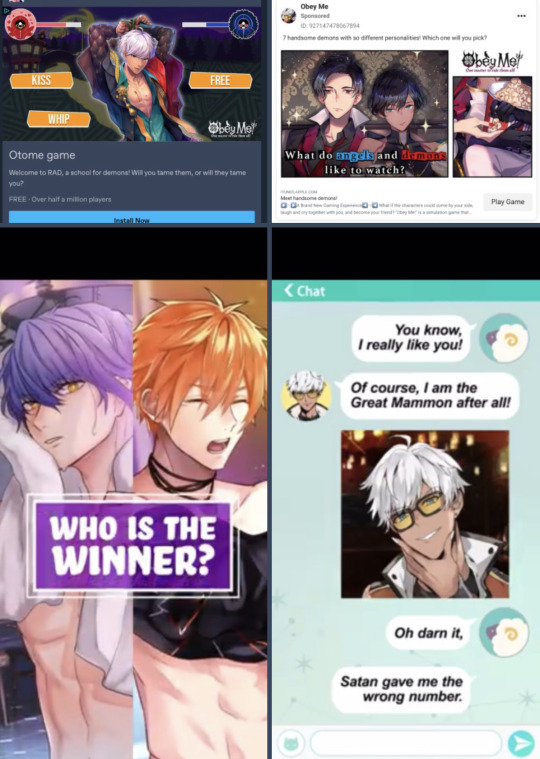
This is a visual novel/otome/gacha card RPG game with the same characters and themes as featured in the ads.
As stated in many of the ads this game centers around seven demon brother love interests (as well as some other potential love interests) although the game has a lot of plot elements other than just romance. Most of the ads that I’ve seen feature real art that appears in the game one way or another, and the ads tend to be focused more on the characters and theme in general rather than specific gameplay. Of the ads that do appear to show gameplay, most of the time it’s not really what you’ll see in the game but still follows fairly close to the actual game (for example, the “kiss, free, whip” ad on the top left doesn’t show real gameplay, but you can kiss or whip that character. But that specific art comes from a gacha card I believe and isn’t what you see when you do the kissing and whipping).

A few notes before I get into the full review:
I’m a lesbian, so I’m definitely not the target audience for this game, but I always try to be objective and open-minded when playing any game I’m not the target audience for (other examples I’ve reviewed in the past are Moments, which was also primarily targeted toward women who are attracted to men, Immortal Taoists, which involved a genre I had never heard of before and really had no interest in, Time Princess, which also wasn’t my favorite genre but was still a great game, and various Genius Inc. visual novels, which are targeted more toward high-school age boys as far as I can tell).
Speaking of lesbians, this game weirdly censors the word “lesbians” but not any other LGBTQ+ terms (that don’t include the word “sexual”) as far as I can tell; I decided it was enough of a one-off thing that it wouldn’t factor a huge amount in my overall review of the game, but I think it’s still something to take note of and not let off the hook since it definitely shows bias and can be offensive to players.
This game is rated 12+ on the Apple App Store, and I was pretty harsh on Crush Crush for being rated that way because I thought it crossed the line with some of its sexually suggestive content. I kept that in mind while playing this one, and personally I don’t think it crossed the line in the same way, at least not from what I’ve played so far; although it does have sexually suggestive content (most often when interacting with the character Asmodeus, who is literally known in the game as the “Avatar of Lust”), it’s much more occasional through tidbits of dialog as opposed to in Crush Crush where it involved a whole section of the game and was more interactive in nature. I would definitely still cringe at the thought of a 12-year-old reading some of this dialog, but I think it fits fairly within the App Store descriptors of “Infrequent/Mild Sexual Content and Nudity” and “Infrequent/Mild Mature/Suggestive Themes.”

Last note - there is a character in this game (Luke) who has the appearance and demeanor of a small child who you can interact with in a similar way to the other love interest characters, which concerned me for obvious reasons. I looked more into this, specifically reading into all of the different dialog options involving this character, and his responses never seem to be more than platonic, which is good. He still blushes when you give him gifts and stuff, which is kind of awkward, and it seems weird to throw a kid character into an otome game, but all considered I wouldn’t say the game is promoting anything inappropriate (unlike one of the Genius VNs that clearly involved relationships between an adult and minors).
Sorry I know that’s a lot of notes and disclaimers but I just wanted to that all out of the way as general concerns anyone might have trying this game or reading this review!
Without further ado, read my full review below:
***
***
***
(I’m trying a new color-coding system to help highlight some of the main points of my review if you don’t want to read my entire essay word-for-word lol. Pink is a positive aspect of the game, red is a negative aspect/criticism and purple is not necessarily positive or negative but just something I wanted to highlight.)
😈 Is the game actually fun? Yes! Just in terms of production value, this game is top notch: the art and character designs are very appealing, the transitions between characters’ poses and facial expressions during VN scenes are actually animated (which looks much smoother and more natural than switching between still images), the voice acting is great (although the VN scenes aren’t fully voice acted, some parts like phone calls are and the characters say different phrases during scenes and battles as well)(Note: all the voice acting is Japanese), and the music is FANTASTIC and perfectly sets the vibe throughout the game.
The best parts of this game in my opinion are the different personalities of the characters and the overall plot; although some of the characters’ personalities can be a bit one-note at times (for example, one character’s entire personality that I’ve seen so far is that he likes to eat and is always hungry), the characters each have their own charm and play off each other well. I found myself getting invested in each of the characters’ desires and goals throughout the story, even the characters I didn’t particularly like. The story is also chock full of humor which is always fun, and the whole world and backstory built around this game (the “Devildom” setting and the idea of an exchange student program with angels, humans and demons) are also unique and impressive.
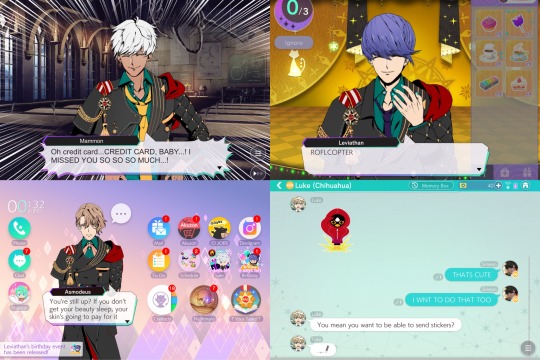
I really enjoyed the multiple modes of storytelling i.e. how the VN chapters are supplemented with text messages and phone calls from characters and an Instagram spoof with additional side stories to unlock. I know this isn’t a new thing in mobile games (even Gardenscapes and Homescapes do it to an extent lol) but add the compelling characters and overall production value on top and it’s a really enjoyable experience. Since the home screen of the game is set up like it’s your phone, with the different parts of the game represented as “apps,” the game kind of creates a feeling like you’re really living in this world with these characters where you can freely scroll through their Instagram feeds and check the messages you get from them on your own time. The shop where you can buy items and premium currency is called Akuzon (an Amazon spoof) and the place where all your gacha cards are is called “contacts,” which further adds to the immersive effect.
The “dating” part of the game is pretty cute although I haven’t gotten super far so I’m not sure of the full scope of the romantic interactions. From what I can tell, in addition to the dialog, blushy faces and bedroom eyes you get from characters when you give them gifts and touch different parts of their body (above the belt lol), when you raise your intimacy level with them you get additional phone calls and messages from them (I haven’t played a lot of otome games but I think that’s how a lot of them go). I wasn’t that invested in this part of the game but I think there’s some strategy that goes with using the right combination of gifts and touches to maximize intimacy boosts and get certain dialog, which adds a whole other aspect of gameplay in addition to the main game. I also noticed that occasionally your choices throughout the VN chapters will give you a small intimacy boost with a certain character; I kind of wish this was even more integrated since most of the time I felt like no matter what I chose it didn’t make any difference in my relationship with characters. Also, I don’t think there’s a way to “officially” date a specific character, it’s more about raising the intimacy level to earn more interactions but it doesn’t actually affect the main plot.
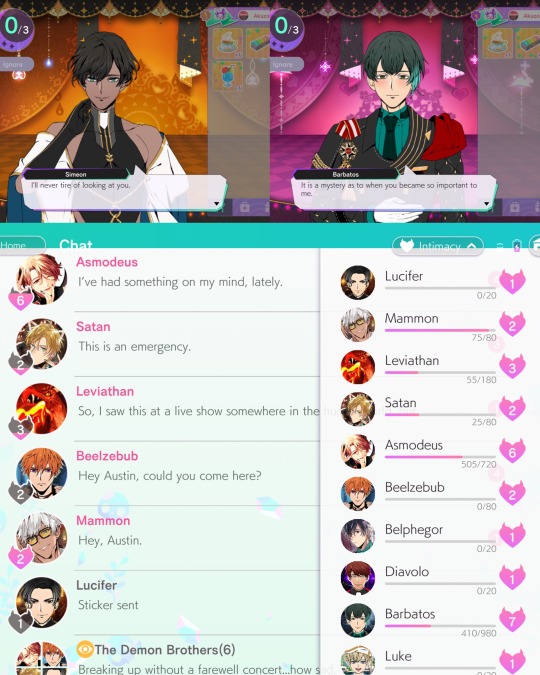
As far as the main mode of progressing through the game, which is winning “dance battles” with teams from your gacha collection, this part of the game has its own positive qualities such as the cute chibi forms of the characters that appear on screen and the fact that some of the special attacks show a little anime clip of the character (of course it’s less exciting when you see the same clip every battle but I still thought it was a nice touch). I was a little disappointed that there wasn’t a rhythm aspect as the “dance battle” name would imply, and your main interaction during the battle itself is basically just tapping hearts that pop up and tapping the characters when their attacks are ready, but you also have the option to skip that whole interactive sequence and just get a result based on your team’s stats, so there’s not much to complain about there (especially since the battles are sort of a side note compared to the storytelling aspect of the game despite being the main element of RPG-based gameplay that allows you to progress). If you are interested in the RPG aspects, there’s plenty of that to work with (building teams, balancing attributes, managing resources/rewards to level up cards and progress through skill trees of sorts, all that good stuff) although you’re limited to an extent by how difficult it is to get a lot of gacha draws without paying real money. It’s even harder to be able to focus on both strategy and character relationships while playing for free when the same scarce currency is used for both gacha draws and gifts.

👿 Is this a free game or a “free game”? Despite what I just said, I would still consider it a free game - you can gradually save up some of premium currency the game gives out through tasks in order to pay for more gacha draws and other items, and as far as I can tell you can access the main story and the other parts of the game without hitting a paywall. I only got to the fourth chapter so far though so don’t take this assessment as gospel. Like with a lot of other freemium games you might feel pressured to pay (especially when you run out of gifts to give your lover boys, which was the biggest downer for me, or if you’re obsessed with wanting to collect a lot of cards or get a specific card) but since you don’t actually need to pay to progress I still consider it free.
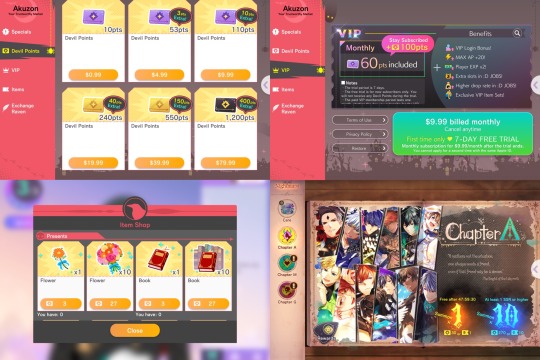
There’s also an energy system where you hit a wall and have to wait if you run out, but I never ran out because of the huge amount of energy the game dumps on you when you first start, and it seems like there are a bunch of other ways to get extra energy as well. There also aren’t pop-up or watch-to-earn ads in this game that I saw.
💀 Features
Main visual novel scenes and storyline (the visual novel scenes come between dance battle stages and there are a few short side routes that branch off but still one main route as far as I can tell, I don’t think your dialog choices really make a different except for in how the characters react to you immediately afterward. Still the main storyline in itself is fun to follow and it’s fun to get different reactions out of the characters based on what you say)
Dance battles (I’m not fully knowledgeable about the minutia of the RPG system at play here but in general the outcome of the battle will depend on the level, rank and attributes of your cards compared against the difficulty and attributes of the stage you’re playing. There also “memory cards” that can be assigned to support your team and expendable temporary boosters called “glow sticks” that boost your stats for one battle. During the battle itself you tap hearts that appear to earn extra points and you can tap your characters when their power is charged up to “attack” your opponent and use special skills. There are guides online that go deeper into stats and strategies and such if you’re interested. Different stages have different rewards for completion and you can quick complete levels you’ve already beaten to mine resources you need)
Gacha mechanic and cards (the gacha area of this game is called “Nightmare” and there are a few different pools along with event pools each with their own odds and sets of cards you can get. For the default pools you get free draws periodically and I believe you get one free draw for each event pool IIRC. You also get a bunch of vouchers for draws when you first start the game which got me handful of SSRs and a couple URs to build a couple of solid teams right off the bat. In addition to drawing directly from gacha pools you can get some cards by collecting card pieces as rewards from stages and events until you have enough to get the actual card. Each card has its own set of stats/attributes, can be leveled up and has a skill tree of sorts that can be progressed through with resources mined through beating stages, although it’s more of an attribute tree than a skill tree since most of the branches just add points onto one of your card’s attributes. Some cards, the rarer ones, have special skills that can be used in battle)
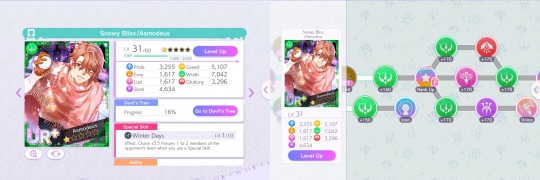
One-on-one characters interactions and intimacy i.e. the “dating” part (there are two ways this occurs: 1) you can set a specific character to your home screen that allows you to enter into an interaction with them, with a refresh period in between interactions 2) the main way, which is through “surprise guests” after dance battles. These surprise guests show up frequently but not always, and they’re always one of the three team members you used in battle, selected randomly. For each one-on-one interaction you can do three actions - either give a gift, touch the character or ignore the character. Sometimes the character will also offer you a high five which counts as an action if you oblige. Different characters have different favorite gifts and touching different parts of the body can get a different reaction depending on the character and your level of intimacy I believe. Your intimacy level with a character increases depending on the combination of actions you perform, and sometimes the character also gives you gifts back like more energy or resources. There are guides for this online as well)
Text messages and phone calls (text messages are the main mode of storytelling outside of the main VN scenes - you get messages from characters or multiple characters in group chats that you respond to with preset messages or stickers similar to how you make choices during the VN parts. Some of the text messages correspond with the main plot as you progress, ex. A character texts you to be in a certain place at a certain time and next VN scene is of you two meeting at that place. I think other text messages also come up when you reach certain intimacy levels with characters. There are certain group messages that you don’t respond to where you’re basically spying on a group chat among characters and just get to see what everyone’s saying. In addition to written messages and emoji stickers characters will also sometimes send pictures. Phone calls are fully voice-acted dialog you have with another character and they seem to pop up when you reach certain intimacy levels - I’ve only gotten ones so far with the two characters I have the highest intimacy with)
Instagram spoof/“Devilgram” (Devilgram is an in-game photo sharing social media app similar to Instagram and the photos on there correspond to gacha cards. When you acquire the gacha card that corresponds to a Devilgram post you unlock a side story, but you also need keys to unlock further scenes from that story, which can be gradually earned through completing tasks and such)

To Do tasks (completing tasks on your To Do is the main way to earn premium currency in the game along with other rewards and resources. There are daily tasks, overall tasks and tasks specific to each character. Examples of tasks are completing a certain stage or number of stages, beating a stage using a team that includes a certain character or reaching a certain intimacy level with a character. There are also beginner missions when you start the game that I think stay available until you complete all of them)
Events (there are sometimes side story events called “pop quizzes” and gacha events that are available for a limited time, or sometimes an event has both a corresponding pop quiz and gacha pool. The pop quizzes are separate chapters with their own dance battles and VN scenes, and the battles will come with reward points that you can spend on different prizes. Sometimes there are unique cards you can only get from an event. Other minor types of events include log-in bonus events and events where you can get special types of gifts for your love interests. There’s also a feature where you can “time-travel” back to old events at some cost but I haven’t explored this much)
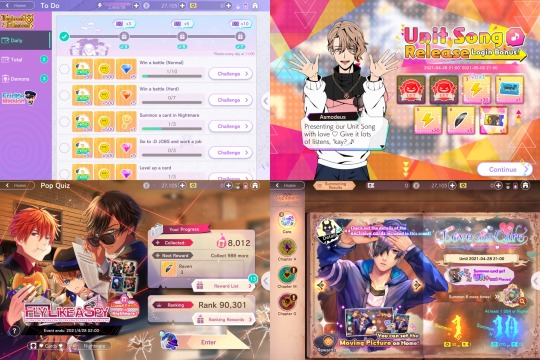
Jobs (you can assign characters to passively complete jobs that earn you a small amount of non-premium currency over time and also increases your intimacy with the assigned characters by a small amount)
Customization (you can unlock avatars of different characters to use for your profile and set the name you want characters to refer to you by throughout the game. You can also change the outfit of your homescreen character, change the homescreen wallpaper and change the homescreen background music by making purchases in the Akuzon shop or acquiring certain gacha cards)
⚖️ Ad Honesty Rating: 4/5 (just from the ads I’ve seen, especially the ones that appear to be running currently, there don’t seem to be blatantly fake ads and the ads show real art and do well conveying the theme and characters in the game. However some of the ads are misleading about the actual mechanics of gameplay and may also lead you to believe there are actual romance routes with the characters which is not really the case)
⭐️ Overall Rating: 5/5 (I definitely didn’t want to give this game a great rating just because it’s super popular on Tumblr but I can definitely see why it’s so popular. There are lots of things to do, the characters are very lovable, it’s funny, the art is great, the music is great and the lore and overall vibe are compelling and unique. It’s a high-quality game with a good story and I’ll probably keep playing it)
▶️ Ad Example:
▶️ Gameplay Examples:
Dance Battles
youtube
Surprise Guest
youtube
If you got through this review bless your heart ❤️ Special thanks to @human-watching-ads-from-devildom which is where I was able to view some of the ads since I was having trouble finding them elsewhere online and viewing some of them on the Facebook ad library.
Follow me for more reviews of those free mobile games you’re always getting ads for! Thanks for reading! 🥳
#obey me#obey me shall we date#otome games#gacha games#visual novels#full review#anime games#rpg#dating simulation games#romance games#war and peace but it’s just a review of a mobile game#sorry if there are typos or mistakes
35 notes
·
View notes
Text
Why Twilight Princess is the Best Zelda Game (To Me!)
Hey ya’ll,
I know I don’t really talk about video games that much. I really should though! Video Games have been a huge part of my life for pretty much as long as I can remember.
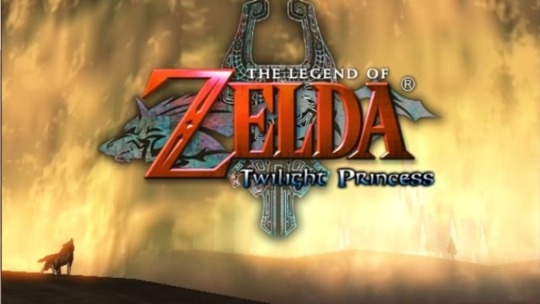
The Legend of Zelda: Twilight Princess is a game that means so much to me I can scarcely put it into words. I was 10 years old when this game came out, the perfect age in my opinion. I think if I had been any older or younger it might have slipped past my radar. Despite the game being rated T for Teen, my parents got it for me and my sister anyway which I think is pretty fucking rad.
Not that we really knew what we were in for, of course. I was just a kid. I didn’t read game reviews yet, and I didn’t have any friends who had played this game so I couldn’t ask them about it either. When we first popped that disc in and were brought to the main menu, we had absolutely NO idea just what kind of ride we were in for or how just how much this game would impact us.
Another thing I’d like to mention was how this game was introduced into my life at the perfect time. My sister and I had just moved schools. We were the new kids, and we had a lot of trouble adjusting and fitting in. There was definitely some teasing, maybe even some bullying. I don’t remember much from those days to be honest. But you know what I do remember? Playing Twilight Princess. This game was the perfect distraction from my crappy school life, and in a time where my sister and I barely had any friends, it was so comforting. We’ve always been close, but I think we bonded a lot over this game.
If you’re a gamer, you know this feeling; the feeling when you are currently playing a game that is just so fun, so amazing, so utterly addicting in the best possible way; that when you’re away from it it’s all you can think about. I distinctly remember my Dad installing the new TV which meant no Twilight Princess for a day or so. I was SO impatient and I just couldn’t wait for him to be done so I could continue playing it.
Even though I’ve now played Twilight Princess so many times that I could basically play it with my eyes closed (maybe lol) I still remember experiencing some of the best moments of the game for the very first time; running around Ordon Village, finding Midna, beating the first dungeon, finding out that GANONDORF was in the game! (Remember I had no way of knowing this at the time). Every big moment, every discovery, every heart-wrenching cut scene, it all felt so real and so important at the time. In a lot of ways, it still is.
Okay, so that’s the personal part. A bit long-winded, I know. I just thought it was important to include for this essay. But what is it about Twilight Princess that makes it so special? Why do I love it so much even after 15 years? (God that makes me feel old). This list isn’t really in a particular order but I will definitely be covering a lot of the BIG reasons why I adore this game so much. Oh, and in case you’re a little late to the party, there will be spoilers. Let’s go!
Darker and More Mature:
There’s something really enticing about being a kid, and witnessing something in a movie, video game, etc. that you know you probably shouldn’t have watched but you did anyway. Not only is Twilight Princess the only Zelda game to date that is Rated T (I’m pretty sure anyway), but it has some seriously dark and disturbing moments throughout the story; including one VERY creepy cut scene about halfway through the game that still haunts me a little to this day. Beyond that, you’ve got painful transformation sequences, characters being stabbed, characters sacrificing themselves, and a scene where I’m pretty sure Ganondorf’s neck just gets fucking broken. I can go on, but the point is this Zelda game does not screw around when it comes to showing intense moments and it’s all the better for it. I never felt the game went too far with it, but let’s say Twilight Princess definitely earned its T rating.
Wolf Form:
I’m sure people who haven’t even played TP know that this is probably the biggest defining feature. In this game, Link gains the ability to turn into a Wolf! I know some people might consider these parts of the game to be boring and not as fun, but I have always disagreed with that notion. I think it’s a really cool and out of the box way to break the somewhat repetitive gameplay of traditional Zelda games. There’s more of a puzzle-solving element to these Wolf sections, and I for one find it very satisfying to collect the Tears of Light. Turning into your Wolf form becomes essential, especially towards the latter half of the game when you need to complete tasks that you couldn’t normally do as a human. Plus…Wolf Link is pretty darn cute! His design is awesome too.
MIDNA!!!:
And speaking of Wolf Link, around the same time Link gains this ability he also meets a character who (in my opinion) is THE BEST Zelda sidekick/companion across all the games. She’s not annoying, she’s not boring; Midna is a 3-Dimensional, fully fleshed out character that plays a crucial role in the story. I can’t imagine anyone playing this game and NOT getting attached to Midna. I know I certainly did. In the first half of the game you don’t really know that much about her, but she is certainly helpful gameplay-wise and doesn’t just give you the same useless hint over and over. Plus, the SASS! My God, Midna is so sassy I love her so much. I love how she grows and changes and becomes a better person by the end of the story. Midna really deserves her own game!
A Beautiful Game:
Now obviously this doesn’t just apply to Twilight Princess. Most Zelda games are very beautiful, especially the more modern ones such as Breath of the Wild. However, there is something about the specific beauty of Twilight Princess that just takes my breath away. The scenery is just gorgeous everywhere you go. Ordon Village is beautiful, Hyrule Field is stunning, Snowpeak is captivating, the Fishing Hole is serene, you get the picture. And to top it all off, Twilight Princess STILL looks beautiful even after all these years. The graphics have aged really well which is certainly no hindrance. As a kid I always wished that some of the locations were real, and honestly, I still kinda do.
Best version of Ganondorf:
It’s funny; I don’t normally root for villains. I tend to gravitate towards more heroic characters or characters that are more similar to me. Ganondorf is certainly the exception; specifically the Ganondorf that we see in Twilight Princess. I remember being SO EXCITED when he first appeared in a cut scene after Arbiter’s Grounds. I don’t know if it’s the way he was introduced, the raspy laugh, or his character design, but I LOVE Ganondorf in this game. He is just so bad-ass, so cool, my only wish is that we saw a little bit more of him in TP. Regardless, every time he shows up in the game, he is a formidable and dominating screen presence. And I feel no shame whatsoever admitting that 10 year old Sam developed a massive crush on this Ganondorf. Is that weird? I dunno, but either way he is just so cool as well as a fantastic addition to an already perfect game.
The Soundtrack:
Again, it’s not unusual for a Zelda game to have a really fantastic soundtrack. The series has always had amazing music since the very first game. However, the music in Twilight Princess continues to entrance me even to this day. The Main Menu theme? Amazing. Midna’s theme? Amazing. Lake Hylia? Amazing. And don’t even get me started on those beautiful Wolf Songs you sing throughout the game. It’s just a beautiful soundtrack. To say it’s nostalgic for me is a massive understatement.
Dungeon Design:
Unsurprisingly, most Zelda games tend to recycle the same temple themes over and over again. You got your forest temple, your fire temple, water, desert, time, etc. These are definitely present in Twilight Princess, but there’s something about the way they’re designed and the way you move through them that just feels so unique and wonderful. I won’t name them but I’ve played other Zelda games where the dungeons felt like a horrible, tedious chore. With TP, I never felt that was the case. Every Dungeon is packed full of secrets, with plenty of interesting set pieces to explore. Even the water temple (YES, the Water Temple!) is enjoyable to play through. The Dungeons have tons of replay value as well, meaning that you can return later and find special items that you weren’t able to access before.
And just as a fun bonus, here’s my top nine list for the Twilight Princess Dungeon’s:
9) City in the Sky
8) Palace of Twilight
7) Hyrule Castle
6) Temple of Time
5) Lakebed Temple
4) Forest Temple
3) Snowpeak Ruins
2) Goron Mines
1) Arbiter’s Grounds
And that about wraps it up, folks! Sorry this was such a long essay, I had so much to say. It is, after all, my favourite video game ever. Of course it’s not technically perfect and it definitely has some flaws. But you know what? It’s perfect to me, and I’ll never get sick of it.
Thank you so much for reading! :) Listen to this track of the opening theme and tell me you don’t feel it in your SOUL!!!
youtube
6 notes
·
View notes
Text
Pirate Material: Still Original
Saw some discussion of The Streets’s early work, and went to see if this article was still online - it’s not because the Vice brand partnership vertical (I’m sorry) that it was originally written for is gone. So here you go again!

I don't hold with the insidious theory that making brilliant art is a young man's game – or, in the words of Sickboy in Trainspotting, that “you have it, then you lose it”. It's a trope that's been with us since the beginning of rock'n'roll, dammit since the romantic poets, that idea that inspiration is intrinsically tied up with the energy of youth, that great works come like a bolt from the blue and artists are best off dying young1 rather than chasing round in ever-decreasing circles trying to relight your creative fire the rest of your sorry life. But it's clearly rubbish, a denial of craft and labour, put about by fantasists and advertisers and used as justification by those with a vested interest in keeping us emotionally immature and by the worst kind of poseurs for their ghastly Peter Pan antics.
Every so often, though, something I see or hear will make me think again – will make me have a flickering moment of belief in the essential white light of youthful creativity. And 'Original Pirate Material' is one of those things. I mean, have you heard it recently? Really heard it? Played it loud from the beginning, given it your full attention, let that utterly insane opening salvo of 'Turn the Page', 'Has it Come to This' and 'Let's Push Things Forward' work their magic on you? It's arm-hair raising stuff, it really is. The false hierarchies and dreary consensus of best-ever lists is another of those things I don't hold with, but yeah this really, really deserved to be on all those best-of-the-2000s lists, and I will gladly fight its corner against the Arctic Monkeys, Dizzee, Radiohead, Outkast, whatever you care to bring in fact.
Like almost all the best music, I didn't really get it at first. It was tinny-sounding and clattery, where I was used to dance music's oomph; I couldn't work out what Skinner's roaming accent was getting at as he slipped and slid across the rhythms, in and out of ordinary conversational cadence, lurching from sublime to ridiculous within single phrases. It was intriguing right enough, but it was impossible to shake the idea that it was all a bit contrived, an indie-weakened version of soundsystem/MC culture, or even more naggingly the idea that it was a wind-up, that this music was taking the piss out of all of us. Lines nicked from 'Gladiator' and talk about his Reeboks? Be serious. And then I had the epiphany.
The scene couldn't have been set better, really. I was out in Amsterdam for eight days on my first ever magazine feature assignment – to cover a conference on Amazon shamanic practice AND a High Times convention. I'd been hanging out with psychonauts, ravers, witch doctors2 and Dutch farmers, and experienced the best that ancient cultures and modern science had to offer; I was in a terrific mood as I was finally doing the job I'd always wanted to, and had been able to utter the immortal phrase “can I claim my ritual on expenses3, please?” on the phone to the Face magazine office. So when someone mentioned “that new band The Streets are playing the Melkweg” I was pretty much up for it.
The DJ beforehand, a Dutchman called Big Head, was playing what was generally known as “breakstep”, a kind of funky uncle to dubstep, and I liked it so much I bought his mix CD4. The Streets were very late coming on, but the crowd were raving and so was I, so who cared? When they did crash onto the stage, though, Skinner immediately and repeatedly asking the crowd if anyone had any cocaine, it was a glorious disruption of the groove, their sound spiky and awkward, and from the beginning I loved it. I don't remember a lot about the band except there was an ex-member of the Senseless Things5 on bass, and that Skinner and his co-vocalist spent a lot of the set pushing, shoving and trying to trip one another up.
And that's when it clicked into place: yes, this was a piss-take, but it was a deadly serious piss-take. This child-like 24-year-old was not just meandering between voices, themes and levels of seriousness, he was embodying every single one of them. He was a shaman too6. What was chaos and what was control became impossible to discern7. The only time I could remember seeing elemental clowning like this before on a stage was the Happy Mondays back in 1990, but I also recognised the spirit of so many loony rave urchins I'd been bamboozled and bantered at and had lighters stolen by over the years8, the never-ending babble of these Shakespearean monkeys, possessed by the endless power of the English language to spin out shaggy dog stories, to make jokes of the most serious matters and suddenly turn jokes deathly serious. The films that were projected as back stories to each of the tracks matched the quotidian urban subject matter of those songs – but they, like the lyrics and the music, revealed something so much more primal beneath. And still you could dance, laugh, drink and carouse to it.
Which is why, when I listen to 'Original Pirate Material' now, I don't hear “bloke poetry” or grittiness or mundanity or social realism any of those other things that are inevitably reeled out. I hear constant windows in to the most profound and abstracted of human instincts and experiences: vertigo, jealousy, transition, glory, loss, innocence and so much more. Just listen to the sudden swerves from domestic detail to dizzying generality in 'It's Too Late' or the affirmation and melancholy in 'Weak Become Heroes': these are about so, so much more than losing a girl or doing a pill9. They're about being human. Only years later did I start realising that Skinner was writing in a great English language tradition going a millennium back to Beowulf and taking in Sterne, Carroll, Lear, Pound, Spike Milligan, Ivor Cutler, Mark E Smith and Roots Manuva10, gibbering gobshites and bullshit artists, holy fools who could skip wildly into parts of our psyches where angels fear to tread.
He could never top this, could he? None of this is to dismiss Skinner's later work – he has on occasion made some glorious music and told some great tales since, and especially on 'Computers and Blues' when he turned full circle back to some of his early themes and freeform lyricism he showed he was tapped into the same wellspring – but 'Original Pirate Material' had it all. Everything afterwards, whether it's his narratives of modern life and celebrity, or his more philosophical turns, couldn't help but be self-conscious, trying to impose more structure onto what he had already expressed so perfectly in its rants, sketches, jokes and asides. This isn't about drugs, it's not about “authenticity”11, and it's not really about youth as such – others have tapped into this very British, very mongrel method of accessing the ways of the human mind from very different places and perspectives – but for Skinner it was all tied into a particular openness to everything that comes with being a hungry young man with his eyes (very) wide open.
--
1 See the infamous “27 Club”, much discussed when Amy Winehouse carked it, and so called because it's the number of times anyone who takes it seriously deserves to have their face walloped with a cricket bat.
2 To be precise, a shaman from the Shuar tribe of Ecuador who played the Jew's harp.
3 Yes, bloggers, these were the days when journalists got paid expenses. They were decadent times, the early 00s.
4 In fact it is sitting on my desk right now, and it still sounds good.
5 You think nonsense genre names like “Post Dubstep” or indeed “Breakstep” are silly? Back in the 90s, The Senseless things were lumped, along with Mega City 4 and Silverfish into a genre called Fraggle Rock. Seriously.
6 No Jew's harp though, just a microphone.
7 You want to know how giddy with the brilliance of it all I was feeling at that moment? My brain flashed up the image of Stockard Channing going “chaos... control... chaos... control... you like?” to Will Smith as Donald Sutherland spun a double-sided Kandinsky in 'Six Degress of Separation'. And what? http://www.youtube.com/watch?v=BjwiachXkjc
8 One routine about fake vs real Nike caps that managed to weave in and out of between-song patter for almost the entire set was such archetypal rave bollocks that you'd swear you'd heard it before from someone who was about to do you out of a tenner at some party on a hillside.
9 They're about those things too, though.
10 Peter Ackroyd's 'Albion: the Origins of the English Imagination' is the book you need on this topic, although admittedly he doesn't get right the way through to Roots Manuva.
11 There's no such thing.
#the streets#original pirate material#uk garage#breakstep#ukg#mike skinner#amsterdam#shamanism#dmt#ayahuasca#cannabis#visionaries#storytelling#poetry#rap#uk hip hop#melkweg
3 notes
·
View notes
Photo
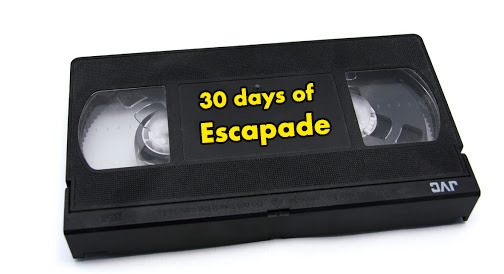
Vidding absolutely counts as a fandom, and Escapade is key to the history of vidding.
Notice how the terminology shifts over the course of Escapade: The first year, it’s ‘songtapes’ being shown, then ‘songvid’ or ‘song video’ predominates for much of the 90s, and then we move on to ‘vidding’ and ‘vids’.
The vidshow moves from being more of a curated presentation of old favorites to having a lot of premieres. It goes from just one night to two, then back to one. Vidshow panels where you just watch vids for a whole panel slot come and go. In 1998, vid review starts up: This is a Sunday morning panel for in-depth critique of the vids shown the previous night and is a famously contentious part of the con. And then there was this:
2002, Friday, 6pm - VividCon Discussion (Come discuss the proposed VividCon, tentative time/location, August/Chicago.)
Yep. Escapade was where Vividcon was born!
By 2008, people were talking about how vidding had moved on from Escapade. In 2011 a vidshow retrospective was added to try to counter the lack of vidding-centric programming. There was a big resurgence for a few years, including such hard-hitting topics as:
2016 - Vidding Aesthetics (”Why is there so much show audio in this vid?", "Why didn't that cut hit on the beat?", "What do you mean 'Cheesy?' She's Celine Dion!" and other immortal questions of vidding aesthetics. If you've ever watched a vid, we want your opinions.)
Why yes, it was my panel. Why do you ask?
There were rounds of warnings wank, caused by Oz vids and by that time Absolute Destiny sent a vid of a violent coming of age film.
Check out this 1994 panel description from Fanlore:
"[The technology in fandom panel] included several things that people can now do in-home that they couldn't do five years ago: cutting and splicing songs on Macintosh computers (to remove inappropriate choruses, verses, or the word "girl"); the soon-to-be-easier ability to select different people from different clips and combine them onto a new background (also for songtapes); printing vhs video frames directly to computer screens, printers and/or color copiers (for fun); and zines and/or libraries on disk. Most of the new technology possibilities were followed by comments that the actual work we can do is illegal [...]. Which comments were followed by the statements that seventeen years ago, writing and publishing a slash fanzine was illegal.... [...] a few people [...], talked to me at different times throughout the con about getting accounts or modems [...]”
This is interesting not just technologically but aesthetically. Is the word ‘girl’ bad in a slashvid? Different communities have disagreed.
Conversations about digital vidding and digital vs. VCR really heated up around 2001, much later than you might expect if you’re coming out of an AMV background. While most of Youtube vids on Sony Vegas--a Windows-only program--at Escapade, Mac has been the norm.
The topics that have remained big are vidding aesthetics, including things like how to make an effective pimp vid, discussions of hosting options and where the community is hanging out now, and how-tos for people who want to get into vidding.
(And before anyone asks, the answer is that you should download DaVinci Resolve because it’s free and cross-platform. And you should encode with h.264 because it’s widely compatible.)
The 2020 vidding panels are:
Vidding 101: The Vid Bunny Farm So you’ve had an idea, and it’s gnawing on your leg? Or maybe you have too many vid ideas and can’t choose? Or you want to make a vid but don’t know where to even start? Aspiring fan vidders, unsure-vidders-to-be, and experienced vidders welcome alike to share vid bunnies, brainstorm together, and talk about the processes of conceptualizing a vid.
Vidding Genres Then & Now We’ve come a long way from “living room vids” vs ‚”con vids‚” or have we? Let’s talk about evolving fanvid genres, from ship vids to AU vids to multivids, from character vids to fake trailers, from genre-bending vids to long form vids to cosplay music videos, and more. Let’s talk about all the genres of fan videos floating around YouTube, Billibilli, AO3 and beyond, and also consider if the old school genre terms still apply.
Escapade has had many, many vidding panels. So many that even I feel the need for a readmore. I’ve pulled out the meta ones and left off some single-fandom vidshows and whatnot. Sorry for the wonky formatting, but Tumblr, in its infinite wisdom, seems to have removed the horizontal rule feature.
1991 - "Classic" songtapes were shown at 9:00 on Friday.
1994 - Song Video Roundtable (Bring works in progress or finished works you're having difficulty with for a quick jump-start. Open to anyone who enjoys videos as well as the people who make them.)
1994 - Songvid Editing (Authors get edited and usually have to do at least one rewrite of a story. Artists have erasers. What stops songvid makers from doing drafts and re-edits of their work? Let's talk about editing style (what cuts to use for best emphasis) and technique (how to physically do the inserts.)) [Notice how much of an issue editing is. These are VCR vids, edited in order, so insert edits are a gigantic pain.]
1995 - Techno Vids—Media Cannibals, (What's available with the new computer hardware and software? Can have Bodie & Doyle screwing on screen if we apply the right touches. Should we? How and when?) [Yes. Sweatily. Always.]
1995 - Video Workshop (video makers & watchers discuss the art.)
1996 - Music Video Critique and Workshop (Roundtable critique of videos, how to tell/recognize story, POV, rhythm. Also, tricks of the trade.)
1997 - Music Choice for Song Vidding (Finding the right song for the fandom is almost as great a challenge as finding the right clips for the song. Discussing what to look for in music choice.)
1997 - Songvid Critique (An exploration of different elements of media vids, with an emphasis on aesthetics. We'll look at segments of different songs to see how the images were used in conjunction with the varied rhythms of the music, and to enhance the mood.)
1998 - Media Cannibals Self-Indulgence Hour (Stunned to look back on vidding effort, MC plans to show -- and talk about -- some of their best and worst vids, pointing out some happy accidents and some annoying f*ckups. This is a great panel for people who want to learn about vid-making, the work that goes into them, and what to look for when watching them.)
1998 - Con Vids vs Living Room Vids (What are the elements that make a music vid accessible to a large crown, or more appropriate to an intimate setting?)
1998 - Music Video Show Review (Selected vids from Saturday's show will be replayed and discussed for their aesthetic, technical and musical choices. Open to all, for feedback and fun.) [Perhaps the start of the Sunday vidshow critique, which was also such a feature of Vividcon?]
1999 - Songvid Aesthetics (An exploration of theme, color, mood, and rhythm. Choosing clips to relate to the music and convey your message to the viewer.)
1999 - Sunday Morning Vid Review (Selected vids from Saturday's show will be replayed and discussed for the aesthetic, technical and musical choices. Open to all, for feedback and fun.)
2000 - Vidding Basics (Or "you want to learn how to make a music vid, huh?"—Carol and Stacy will take a group of novice vidders from the basics of what you need on your VCR, to all your hardware set ups, thru the selection of music, to actually doing some hands-on putting a dip (or two) into a music vid. So if you're interested in music videos and you want to try your hand at making one... you know what panel you need to go to.)
2000 - Songvid Appreciation 101 (Remember Art Appreciation? "Why is this painting good?" Well, we're doing the same for vids, using examples from the ESCAPADE Video Show. Let's take advantage of the fact that we've all just seen these vids, and use them to illustrate how to do cool things in a vid. We'll look at clever POV changes, appropriate choice of music to theme, skillful uses of musical changes within a vid, storytelling techniques, changes of mood, cutting on the beat vs. cutting on the lyric line, the different approaches to serious and humorous vids, or single fandom vs. multiple fandom vids, and more.)
2001 - Vidding Workshop (2 hours) (This workshop will cover: a comparison between digital and analog vidding; a how-to for analog vidding; a how-to for digital vidding; and a discussion of the artistic side of vidding, including song and clip choices, and techniques to avoid.)
2001 - Impact of Computer Tools on Vidding (Vidding used to be push-and-pause between 2 vers, and a LOT of patience. Now with I-movie and Final Cut and Macintosh G4's, the technological leap is here and it isn't going anywhere. Are vids better for the technology available to them?)
2001 - Songvid Appreciation (2 hours) (Comments and feedback on vids you saw last night, Escapade style.)
2002 - Art Manipulation Using Photoshop (A how-to overview, with demonstrations in Photoshop, and more detailed techniques for creating photo manipulations, web graphics, and zine graphics. Depending on interest, creation of vid titles and overlay vid graphics may be included.)
2002 - Digital Vidding (An overview of the digital vidding process, including some advice on the hardware and software you need to get started. Learn the basics of editing with Premiere and similar programs, and get an overview of some of the fun options you have when using a computer to vid.)
2002 - Vidding Workshop: Art After Craft (What is the Art of Vidding?)
2002 - Vid Revision (The art and craft of revising vids—how you get from a song in your heart and a bunch of clips on your hard drive to the final product. We'll show multiple versions of a few vids, critique them, and talk about what improves a vid. No technical knowledge needed; come whether you make vids or just like watching them.)
2002 - Vids: Pro vs Fan Editing (A long time fan vidder and a professional editor discuss techniques.)
2002 - Sunday Morning Vid Review
2002 - VividCon Discussion (Come discuss the proposed VividCon, tentative time/location, August/Chicago.) [VVC started 6 months later, in August 2002, and ran until 2018]
2003 - How to Vid on the Computer (A brief intra vidding on computers. It will touch on hardware requirements, software options, and basic concepts of non-linear editing and what makes for a good vid, and, time and tech permitting, it may also include a demonstration of some of the editing basics. There will be handouts.)
2003 - Vid Show Review (A discussion (and literal re-viewing in some cases) of some of the vids from the Saturday night show.)
2003 - Also Premiering Vid Show (The "Also Premiering..." vid show is for vids premiered in the last year that aren't going to be shown in the Friday or Saturday shows. This will be an informal setting and we'll go by participant preference — if folks want to see a vid a second time, or want some time to chat about it, or if a vidder wants some feedback on it, we can decide to do that on-the-fly. If you'd like to show any vids in this show, just bring them to the show itself. There are no hard-and-fast limits on number of vids; we'll just go with what shows up and take turns until we run out of time. Afterwards, consider going out to lunch with other participants to talk about the vids!)
2004 - I want to vid! (But I don't know how) (Introduction to vidding hardware, software and maybe some concepts if we have the time.)
2004 - Made On a Mac: The MacFen Symposium (So you're a slasher and a Mac user. Come and share your tips and tricks for HTML coding, photo editing, website management and vidding on a Mac, Share the programs that have and haven't worked for you and hear some helpful tips from the front lines.)
2004 - Vidding: Creating Mood (Why do rapid cuts of short clips create tension? What does a wipe *feel* iike? A vidder's toolbox Includes more and more options, but how do we know what emotional effect each technical effect will produce? Leave the music at the door; this one's about the visuals.)
2004 - Editing Techniques and Vidding (How can you edit together clips from widely different episodes and movies into a seamless whole? A familiarity with concepts in filmmaking can help you achieve the results you're aiming for. A look at some of the common rules of continuity editing and how they relate to vids.)
2004 - The changing face of vids (How has increasingly cheap technology, wider highspeed access and the new flood of vidders changed vidding? What should we rejoice about and what should we worry about? How do we help make it a winning situation for all?)
2004 - Vid Review (A retrospective on the Saturday night show.)
2005 - Vidding: Let the Lyrics Help You (How to look at lyrics to add depth and structure to your vid. or why top 40 songs usually make you do all the work.)
2005 - Vid Review (A Sunday morning tradition at Escapade, and a chance to discuss those great vids.) [See how it’s a “tradition” by this time.]
2006 - The Changing Vid Audience (The move to digital vidding, the availability of vid source and software, and the expectation of online distribution have all radically affected audience desires and expectations. What do audiences want from vids now? Vidders, share your historical perspectives. Vid fans, this is your chance to tell vidders what you want.)
2006 - Defining the Character Study Vid (We love character study vids, so how do you go about making a good one? What's the difference between a vid about a character, a vid about a universe, and a vid about seeing the universe through the eyes of a character?)
2006 - Marketing Your Vid (How can you stand out among the swelling ranks of vidders? What's the best way to present yourself, and to draw attention to your work? We'll focus on knowing your audience, timing your release, pimp communities, etc.)
2006 - Vid Review (Like Ebert and Roper, but much better looking.)
2007 - Ulead Media Studio Pro 8 and Why It's Better Than the Rest (A compare and contrast of the semi-professional video editing software programs with a strong emphasis on Ulead Media Studio Pro 8. If you are new to vidding, or interested in upgrading your video editing software, this panel should help you make an informed choice.)
2007 - Mac Workshop (The ins and outs of vidding on a Mac.)
2007 - Vid Show Review (Take apart what worked and what was missing from selected vids in the Saturday show. Audience participation at its finest.)
2008 - Ulead Video Editing Introduction (Intro to Ulead Video Studio/Media Studio Pro for those who are interested in vidding but don't have a clue as to where to start. or wouldn't mind a refresher course.)
2008 - Vid Review (Last night was for watching, today is for analyzing. What worked, what didn't, and why?)
2009 - Fannish Aesthetics: Extrapolation v. Subversion (How do we as writers (and especially as vidders) interact with the source material? Is that relationship evolving? What can we say about where we've been and where we're headed?)
2009 - Vid Review (Last night was for watching, today is for analyzing. What worked, what didn't, and why?)
2010 - 2010: A Vidding Odyssey (Current trends in vidding, including what's changed and what's remaind the same when it comes to slash, vidding in particular. We will show some examples of "classic" slash as well as some of the newer develpoments in constructed reality.)
2010 - Vid Review
2011 - Escapade Songvid Retrospective (A trip back to the days of yesteryear, when vids were made on VCRs and Escapade was the place for vids and vid programming. Compiled by Kandy Fong, this show will survey vids from a variety of vidders and shows, covering Escapade 1992-2001 in a fun, informal environment.)
2011 - Decoding Vid Meaning (How do you read a vid? Clip choice, lyrics, structure, symbols or the tone of the music— vids offer plenty of clues, and we decipher them as we see fit. Come watch a vid (or two!) and discuss how we get meaning from what we see and hear to develop a deeper understand of what's going on in the vid. Multiple viewings are required!)
2011 - Vid Review (Flash all the way back to Saturday night to dissect our favorite (or not) vids from the show.)
2011 - The Vidding Explosion (1985-1990) (Who taught whom. The growth of storytelling, technique, and sophistication. Includes vid show and presentation.)
2012 - Vidwatching 101 (Vids have their own language and their own framework for discussion. It can be tough to translate vids into words, but if we have the same language, vid discussion can be wonderfully rewarding for both vidder and viewer. This panel is a primer to get us all on the same page.)
2012 - The State of Vidding Fandom (Ten years of VividCon and roughly the same years vids have been distributed online, let's talk about the state of vidding and the community of vidders. Is there one? Where is it? How do vidders fit in with fandom at large? What are the different options for watching/releasing vids, and how do they stack up for vidders and viewers? If you love vids, join us—whether you vid or not.)
2012 - Festivids Review (Festivids is a fannish vid exchange inspired by the Yuletide fic exchange. This will be a vid review-style panel where we show clips from some of this year's highlight vids and talk about the challenge.)
2012 - MVD Vid Retrospective Show (Sometimes the oldies really are the goodies. Mary Van Duesen has made songvids since the 1980s, working in a range of fandoms. She has also remastered many old vids, and they look better now than they ever did. Come see some old favorites, or find some new ones.)
2012 - Vid Show Review
2012 - Nearly New Vids (So many wonderful vids were submitted for the Escapade show that we couldn’t fit them all in the early show. Here’s your chance to see the rest in the daylight hours (replay of the late-show vids).
2013 - Mac Vidders Roundtable (What’s the best way to vid on a Mac? Our vidding options have changed a lot in the last few years, and it’s been a while since we had a roundtable to discuss and compare our tips, tricks, and processes. This panel is for all of the above.)
2013 - The Art of the Pimp Vid (What makes a pimp vid so addictive one hit will get you hooked? Let’s talk vids for people outside of your fandom. Plot arc vids, character vids, pairing vids: How do you grab a new audience hard and never let them go? Hey there, little fangirl, the first taste is free!)
2013 - The Bestivids of Festivids (This year’s Festivids featured everything from incest testtube babies to care bear Avengers to a surprisingly large amount of kickass femslash. Let’s watch and discuss some favorites from Festivids 2012.)
2013 - So You Want To Be A Vidder (Nobody vidding your OTP anymore? Sad that vidders haven’t discovered your new favorite show? Why not vid it yourself? Come learn the very basics, from choosing programs in your price range to dos and don’ts if you’re planning to submit to cons.)
2013 - How Do Vids Work? (Let's talk about the techniques (not just the feelings!) that make a slash vid work. What makes for a vid that we watch over and over and that sticks with us long- term? We'll talk about these things with reference to a couple of specific vids, see what strategies, commonalities, and differences we can identify, and then open up discussion to additional favorites from the audience.)
2013 - Vidding Aesthetics (Vidders and vid watchers: let’s talk vidding aesthetics. How have styles changed over time? What makes a good vid and what’s just a matter of personal taste? What do you want to BURN WITH FIRE? Let’s get this cage match... err... discussion going.)
2013 - Vid Review (Flash all the way back to Saturday night to dissect our favorite vids (or not) vids from the show.)
2014 - Vidding 101 (Never edited before? Haven't made a vid since the VCR went the way of the dodo? Come learn how to turn those vidbunnies into reality!)
2014 - Vids for the Viewer (We often discuss writing from the perspective of a reader, but vidding from the perspective of vid-watchers not so much. Let's talk about how to read a vid, different vidding aesthetics and how accessible or popular they are with viewers vs. vidders, and impostor syndrome in vid review.)
2014 - Vid Review (Flash all the way back to Saturday night to dissect our favorite (or not) vids from the show.)
2015 - Best of Festivids. From the slashy to the merely sublime, what tickled our fancy in this year’s Festivids?
2015 - The Perfect Slash Vid. What makes the perfect slash vid? Is it the song choice? The point of view? The abs? (Okay, you got me: it’s the abs.)
2015 - So You Wanna Be A Vidder. Bring your laptop or at least a pen and paper and find out how to get started in vidding.
2015 - Vid Review: Flash all the way back to Saturday night to dissect our favorite (or not) vids from the show.
2016 - The State of *Vidding Fandom. Sunday, Noon, San Diego 2. What's going on in vidding fandom today? Where are people hosting and posting? What's next?
2016 - Vid Review. Flash all the way back to Saturday night to dissect our favorite (or not) vids from the show.
2016 - Vidding Aesthetics (”Why is there so much show audio in this vid?", "Why didn't that cut hit on the beat?", "What do you mean 'Cheesy?' She's Celine Dion!" and other immortal questions of vidding aesthetics. If you've ever watched a vid, we want your opinions.)
2017 - Vidding 101 - Have you dreamed of making a vid but just aren’t sure where to start? We’ll go step by step, talk finding your source(s), choosing music, finding your way with non overwhelming tech-tools, brainstorming ideas, finding collaborators, and learning by doing. Already a vidder? Come and help new vidders find their way, find new collaborators, and make new ideas happen.
2017 - Let’s Collab! New Forms of Collective Fan Creativity , Newport Changing technologies mean that we collaborate with each other in ever-evolving ways when we create fic and vids. What are the possibilities for collaborating beyond geographic boundaries with digital technologies? How are you collaborating with fellow writers and vidders these days? Are you interested in finding new collaborators and new ways to connect? And are these new forms of collaboration creating new forms of creative fan work?
2017 - Vid Review, Marina del Rey On Saturday night, we watched the vid show. On Sunday morning, we talk about it. Join Rache to discuss the good, the better, and the great of the show, including techniques and all of the reasons Charlotte doesn’t vid anymore and never will again.
2018 - Noon (Vids from the Vault, Part One Kandy Fong Newport A curated retrospective of vids from early Escapades.
2018 - Fanvid Feels (What vids do you return to again and again because they just make you *feel* things, thrill you, or fill you with joy, or even sadness? Maybe a vid introduced you to a pairing, or a fandom, or perhaps you love it even though you’re not really that into the source? Let’s look at some of our/your favorite vids and think about what makes them tick. Come with vids you want to talk about in mind, or just come to watch and talk about vids that make us feel stuff.)
2018 - Vid Review (Flash all the way back to Saturday night to dissect our favorite (or not) vids from the show.)
2019 - 3-Minute Pimp Vid (Forget telling: Show us your canon with a vid or clip! (3-5 minutes each.))
2019 - Lend Me Your Ears: Vids and Music (Have you ever discovered a song or musician because of a fanvid? Do you have thoughts on what music works and doesn't with fan vids? Let's talk about all the ways in which different types of music can work in vids, and look at some vids that work with music in awesome or surprising ways. Plus maybe there will be a little singing along...)
2019 - AO3 But For Fanart and Fanvids (AO3 has been great for fic, we need safe harbors for art and vids too. Let's talk about it!)
2019 - Pitch a Vid Bunny, Find a Vid Beta (Have an idea for a fanvid you'd love to see happen? Come with concept, song, source ideas, characters--share your bunnies, find some cheerleaders, brainstorm together. For newbie & experienced vidders alike, all welcome!)
2019 - Vid Review (Rehash the Saturday night vid show with a room full of fans.)
16 notes
·
View notes
Text
Lacuna Coil’s Cristina Scabbia wants you to “lay down on your bed, close your eyes and come on a journey with us”
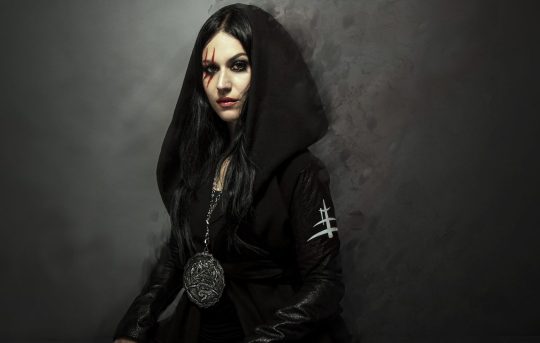
For two decades now, Lacuna Coil have been one of the most consistent voices in heavy metal. Since their debut album ‘In A Reverie’ in 1999, they’ve averaged a new record every two or three years; always ambitious, always as gothic as Hallowe’en in a bat roost, always abrasive… and at the heart of it, always featuring the gargantuan lungs of singer Cristina Scabbia.
Surprisingly for a band so far into their career, new record, ‘Black Anima’, their ninth, contains the best songs the Italian band have ever committed to tape. It’s a deeply personal work, with recent events in Cristina’s life inspiring much of its content. “This isn’t just a heavy record in terms of it’s sound,” says Andrea Ferro, who shares vocals in the band with Cristina. “The words are heavy, the tone of the record is heavy, it’s a very emotional record. I think this and our last record are the most personal records Cristina has made…”
NME thought it time we asked Cristina about the making of ‘Black Anima’, a record that explores sadness and pain in unflinching detail – but also that revitalises the veteran stars.
Cristina, you’re recently described your new album as ‘the heaviest and darkest’ album you’ve ever made. Metal bands always say this. Do you really mean it or is it just something to say?
“We really mean it. I’m even more convinced of it the more I listen to what we made. I think our last record [2016’s] ‘Delirium’ was heading in that direction and ‘Black Anima’ is a natural progression from that record…”
You’ve been doing this now since 1994. Normally bands get more mellow the longer they go on…
“Well, I certainly don’t feel like that as a person. The older I get the more curious I get. I feel like going from ‘Delirium’ to ‘Black Anima’ taught me so much about myself. I lost both my parents in a very short period of time and they literally were the world to me. We’d talk every day. Multiple times a day. It was so shocking to me to lose them…”
I’m sorry that happened to you Cristina…
“It happens. They lived a long happy life and I was lucky to have them for so long. But I have realised that I am much stronger than I thought I was. For years before I was trying to prepare myself for it happening. I was trying to visualise how I’d cope. I used to tell myself what it would be like. I thought I’d lock myself indoors, shut out my friends and be completely depressed – and then I learned that you do just go on. You have to carry the torch. I feel bulletproof now. I’ve lost the most important thing in the world to me, and I’m still here.”
In all the time you’ve been doing this, what’s the biggest change you’ve seen? Being in a band now is so different to how it would have been starting out in 1994…
“Everything is so much more complicated. Social media has made everything so fucked up. Everyone wants to look beautiful and perfect and smiley and rich and that’s just a distorted version of anyone’s reality. I think people dug deeper before these times. Now everything is so transient. A band release a new single and in another two days another band releases a new single and the previous song is forgotten. I’m sick of hearing about views and numbers and streams and… shit. I think there’s poetry behind the creation of music and songs – and there’s nothing poetic about social media.”
Lacuna Coil come from Milan, Italy – not a country famed for its export of heavy metal…
“Well it was just so different back then. We used to send cassettes with our songs on to record labels. No email, no smartphones… I still can’t believe how lucky we were to be noticed – this little band from Italy – by our label, Century Media, who we’re with even now. We were the first band they signed outside of their circle in France. We were so surprised to get a call from them. Metal is, even now, a real underground genre in Italy. There’s a few more bands now – we’re good friends with the band Fleshgod Apocalypse – but the scene is still very underdeveloped. There’s not many opportunities for bands to break out. The radios don’t play metal, the clubs are weird sizes – loads of 500/600 capacity venues in Milan just closed down, so venues that are left are either too small or arenas, so it’s hard for touring bands to find anywhere to play.”
This is a question that separates the progressives from the old farts. Were things better then?
“Ummmmmmmmm… Yes and no. I think things were more exciting back then, because there was just less of everything. Things that have largely been eradicated now, like waiting for the release of a record, have been lost – and these were great things! I miss queueing up outside record stores! I miss patience! Everyone wants everything immediately now, and I don’t think that’s always good for you. I think there was probably more respect for music as art too…”
Would you like me to warm your slippers by the fire, Cristina?
“Yes, well, the good thing about the present times is that bands can access a bigger audience easier. I would have loved Lacuna Coil to have had access to something like YouTube in the beginning. The idea you can form a band, record a song, upload it and someone in Australia can be listening to that song the same day is still mind-blowing to me. There’s just more chances. More opportunities to showcase. This is a great thing – I just wish it all wasn’t such a clusterfuck! I think the idea of bands having 25-year careers now is quite unlikely.”
What it sounds like to these ears, Cristina, is you’re looking for music to have more permanence than it does right now…
“I think there’s something in that, though I’m just frustrated with how much music has to compete with right now, really. There’s so much noise competing with people for their attention. Why is everyone trying to go viral by kicking a bottle top off a water bottle?”
Can you kick a bottle top off a water bottle Cristina?
“No I cannot. I haven’t tried. But I get it. People want to be entertained. Little fixes of entertainment. That’s what we’re competing with. To be something more.”
How do you do that, though?
“Well we’re trying to do things in a quite old-fashioned way. We’re trying to write records, not songs. On the new record there’s an intro and an outro, and you should try to enjoy the record in its entirety. We’re trying to get an hour from people to lay down on their bed, close their eyes and come on a journey with us. That’s the goal. We like to try to add a visual element to our records too. This time we’ve made tarot cards with the record, which I think suits it because it’s a very – how do you say? – esoteric record, in a spiritual way. There’s a card for each song, designed by the artist Micah Ulrich. I don’t really believe that tarot can tell the future, but I do think they’re a good visual to show where you’re at in your life.”
“There’s a book we read that we found inspiring – it was the spark that led to ‘Black Anima’ really. It’s called The Physics Of Angels [Full title: Exploring The Realm Where Science And Physics Meet, by Rupert Sheldrake] which is a conversation between a theologist and a scientist. It got us thinking about why people need to believe in a protecting presence – where does that come from? It inspired a lot of the album’s artwork and theme, and even a few of the songs.”
Which side of the fence do you fall on Cristina? Are you team science or team theology?
“Science. 100%. Actually, let’s call it 80%. I still understand the spiritual part and I do hope there is something in us that lasts. I want to believe my loved ones are still around me in the form of energy, but I don’t have any proof. That stops me from blindly believing. Obviously Italy is a very religious country. We have the Pope. But while I grew up going to church – my parents were believers – I never did believe. I used to just be confused why I had to go to church every week. I didn’t understand why people didn’t behave like they said they did in church. I always thought it was more important to be a good human being, to be a respectful human being, without any fear of God attached to it.”
Before we part ways, I just wanted to say that my assessment of ‘Black Anima’ after living with it for a while, is this is absolutely a record made by a woman who is living with an unbelievable amount of pain…
“In parts, absolutely. There is a realisation throughout this record that it is sometimes okay to not be okay. I don’t think darkness is wholly negative. We learn who we are in darkness. Sadness is a huge part of life. It’s okay not to be happy. I guess what I’m trying to say is that I’m always trying to look for the light in the darkness, but it’s okay to live within the darkness for a bit too. I think when you embrace all the shades of life you can live a happier life than if you deny any of it.”
On a scale of one to ten – ten being very happy, one being very sad – where do you think Cristina Scabbia ranks right now?
“I think I’m on an eight. I’ve been down, but I’m here.”
15 notes
·
View notes
Text
It’s show and tell time!
This spiel is courtesy of @thewriteblrarchives and their NaNoWriMo Support Group. Let’s talk my process and my NaNo project for this November. It’s really long, so I’ve put it under the tab; enjoy!
Questions for you:
How long have you been writing?
I’ve been writing for as I can remember, honestly. I used to write little stories and poems long before I entered kindergarten. By the time I was in late elementary school, I was consistently planning more coherent stories. I never finished one of them, though.
When you start a project, how do you start? With character, setting, plot, aesthetic, something else?
So inspiration usually hits me like trucks hitting anime protagonists. Sometimes the foundations of a character I find interesting will inspire me, other times it’s a setting. There’s been at least one time that I’ve seen a trope I really liked an off-shoot of that I wanted a full story about (i.e. found family where they’re actually friends and don’t act like they secretly hate each other).
What’s your favourite part of the writing process?
World building is hands down my favorite part of the writing process. I have way more worlds than I have stories for. Normally, I’ll only have vague concepts for characters and a plot until I have a solid world I can play around in, so world building is also one of the longest parts of my process, too.
What genres do you write?
I write a lot of fantasy. Like a lot, a lot of fantasy. Realistically, it’s usually leaning more into science fantasy, but it’s still always very definitively a fantasy world. Everything I write usually has some LGBT+ , aspects of adventure, and potential romantic subplots.
Where’s the strangest place you’ve ever written?
I think it’s personally stranger when I write in a normal place like a cafe, library, or on a desk. I tend to write on the go -- in cars and buses -- and I was scribbling stories throughout my classes and college prep program.
Questions for NaNo:
Have you participated in NaNo or camp NaNo before?
I almost participated in NaNo eons ago, but I chickened out on October 31st. Ever since then I’ve always considered it and just never went through with NaNo or any Camp NaNos.
What made you decide to join up?
So I’m kinda always thinking about joining NaNo and chicken out at the last minute.I’m an expert at making excuses for myself where creative writing is involved! But a little before I finally decided to join I saw this Preptober video by Alexa Donne on YouTube. I had been watching writing tips for a few days because I was distressed about how little I’d been writing recently. Seeing that really just made me decide that there’s no time like the present; even if it’s horrible, I love writing and I just gotta do it.
What are you most excited about/looking forward to?
I’m really, really excited about where this story’s going (in part because even I don’t really know yet). I’ve fallen in love with these characters and there are so many routes their arcs could go. I’m still nailing down an embodiment of an antagonistic force, though, so that’s something I’m looking forward to coming together.
Anything you’re a bit nervous about?
Writing in general, haha! I’ve never successfully written a full-length manuscript before and I’m trying to just go in order for NaNo so I get the experience of it. I just finished the first chapter and cried because I felt so relieved. My favorite part of the novel to write is the middle, but I need a lot of improvement and motivation for the beginning and ending; I’m glad to have the first chapter weight finally off my shoulders.
Have you done a lot of preparation? Or none whatsoever?
I’ve done some prep for my novel. Key word is some. I started prep work on October 16th with a brand new idea, so I was bound to be pretty behind on planning in general. But I’m also a total pantser, so I was trying planner for a change. In the end, I had established my protagonists, the world, and a vague sense of the plot. I also nearly created a language as a part of the PoV character’s culture.
Do you have a workspace, schedule, or daily goal?
In theory, I have a daily goal of 1,667-2,000 words. Because I’m writing a fantasy, I want to get as close to the average word count of my genre as possible. In general, I tend to write at night after work and on my way to work, but I’m trying to wake up earlier so I can write in the morning and not have to transcribe it from a notebook later. I usually write at home, typically isolated in a bedroom.
Questions for your wip:
What’s your NaNo wip titled (if it has one)?
If We’re to Carry Stars
Tell us a bit about your NaNo wip! For example the plot, genre, themes…
If We’re to Carry Stars (IWCS) is a fantasy adventure novel set in the world of Eondes. Thousands of years before the beginning of the story, Eondes chose the Yuvel as its protectors.The Yuvel were merely a race of healers with a high magical aptitude; their styled after nymphs, elves and fairies, with pointed ears and features meant to mimic the planet itself (fiery eyes, green hair, blue blood, etc.). In exchange for protection, Eondes granted the Yuvel access to its magical core, which they were tasked with keeping clean. It gave them elemental magic and strengthened their healing magic. Over the years, the Yuvel had managed to eliminate all known illnesses and dutifully served Eondes.
However, their protection came at a price. Not only has accurate records of old cures and ailments fallen from folklore and records, but no one’s immune systems were prepared to battle any future threats. Faith in Yuvellen magic had made these things unnecessary.
Until now.
A magic-resistant illness has begun to spread through Eondes’ other races. Meanwhile, Eondes’ magical core has begun to pollute, thus weakening the Yuvel with an illness of their own. Many Yuvel have begun leaving their home on Yuvellse in search of answers and a cure, while other races have followed in suit. Faith in the Yuvel has plummeted and tensions between races rise as unlikely alliances strive for Eondes’ hope.
In the midst of such dread, a Yuvel named Eiríńé finds herself wrapped up in one of these quests as she searches for happiness in a dismal life.
Themes: I want to play with the concept of love and selfishness. Is it more selfish to remain where you’re unhappy or is it more selfish to leave in search of happiness? How do you communicate love? How do you communicate your needs when it comes to love, such as styles of affection? I would also like to play around with some other things, but they’re not as concrete yet.
What is your protagonist like?
So I’m playing with the 5 Man Band trope, and therefore have 5 protagonists with one as focal PoV character
Eiríńé in the focal character and the PoV character (as much as she can be in a third person limited perspective). She’s quite a soft-spoken and hesitant Yuvel. Because she frequently second guesses herself, she ends up taking forever to make a decision. She’s rather kind and strives to be a people pleaser. But she’s also horrendously cynical and deeply discontent with her own life. At the beginning of the story, Eiríńé is engaged and has a good, supportive network of friends and family, none of whom seem to realize how deeply unhappy she is with her life. She makes the decision to leave her life behind and join the others on their quest once Mirunise prompts her to make a brash decision and said impulsiveness lights her heart unlike anything before.
Mirunise is the party leader. She’s a Capescu, a shape-shifting race that can shift into any animal they can imagine; they have heightened sense in their default form. Mirunise is a bubbly paragon with a hurricane for a personality. She’s bombastic and aggressively friendly, to the point Ayondi is frequently trying to calm her down. Her cheer and smile is considered infectious. When confronted with negativity, her optimism usually takes the competitive form of refusing to let the source of said negativity win. Because she’s such a dominating force of personality, she can come off as insensitive and/or rude to some; whenever this is pointed out, she quiets and displays an aggressively compassionate side that’s surprisingly a great listener. Mirunise comes across Ayondi and V'haǵir on her way to see her father. Upon learning of V'haǵir’s condition and ambitions, Mirunise quickly joins their group and spearheads them forward.
Ayondi is V'haǵir’s childhood friend. She’s a Darunshin, a human-like species with bird wings that grow and shrink on command, they have an almost supernatural strength. Ayondi is calm and reserved with a deep motherly streak. She cares deeply for other people, but has a habit of expressing it through nitpicking. She is both the most intelligent and has the most common sense in the part; her strategies tend to fall on deaf ears, though. She’s a realist, but a pessimistic side grows after V'haǵir falls ill; everyone who’s contracted the illness thus far as died, and she fears her days with him are numbered. So she picks up V'haǵir‘s quest and decides that she’d rather save others from the grief of loss than just wallow in her own.
V'haǵir is Ayondi’s childhood friend; his illness is the catalyst for his initial quest with Ayondi to search for a cure. He’s a Wevri, an aquatic race with webbed ears and control over existing water. V'haǵir is boisterous and optimistic, a typical paragon like Mirunise. He’s excitable and generally cheerful. He’s the least thrilled about combat in the party, too. In life, he wants to make everyone happier than he’s ever been (and seeing as he’s almost always been generally happy, that’s a lofty ambition). When he first exhibits symptoms of the illness, V'haǵir laments his poor luck and feels discouraged by the lack of a cure. However, he quickly decides that he doesn’t want to idly wait for death and sets out on a quest for a cure, even if he may never live to use it for himself.
Somayn is the last person to join the party before Eiríńé. He’s a Zuifeel, an elf-like race with pointed, drooping ears and a magical connection to nature. Somayn is quiet, but friendly. He’s very worldly and often acts as a sort of folklore guide for the rest of the party. Despite being generally intelligent, he doesn’t really have a great deal of common sense. He’s realistic, calm and collected, and emotionally open with his allies; he sees no point in lying or hiding one’s feelings. On their travels, Mirunise, Ayondi, and V'haǵir find him in the middle of battle (more specifically on the losing side) against a group of bandits. Somayn decides to join their quest after he’s been healed of his injures, citing a need to scour Eondes’ libraries for potential cures.
Have you been planning it for a while? Conversely, do you know anything about it yet?
I wish I could say that I’ve been planning IWCS for a while. But I started planning this story October 16th of this year and started writing it on November 1st. I have a solid handle on the main characters and the world of Eondes, but it’s still up in the air where it’ll all go.
#NaNoWriMo 2019#NaNo 2019#NaNoWriMo#NaNoWriMo Support Group#Writeblr#My Own Process#Oh My#Long long post
4 notes
·
View notes
Text
Favourite music of the decade!
This is some of what I’d consider the most innovative, artistic and just great to listen to music from 2010-2019.
First a Lot of very good songs:
Crying - Premonitory dream
Arcade Fire - Normal person
Sufjan Stevens - I want to be well
Deerhunter - Sailing
Foster the People - Pumped up kicks
Carly Rae Jepsen - Boy problems
Grimes - Butterfly
Travis Scott - Butterfly effect
Future - March madness
Kanye West ft. Nicki Minaj et al - Monster
Juice Wrld - Won’t let go
Danny Brown - Downward spiral
Kendrick Lamar - Sing about me, I’m dying of thirst
Kate Tempest - Marshall Law
The Avalanches - Stepkids
Iglooghost - Bug thief
Vektroid - Yr heart
Ariel Pink - Little wig
Mac Demarco - Sherrill
Vektor - Charging the void
Jyocho - 太陽と暮らしてきた [family]
Panic! at the disco - Ready to go
The Wonder Years - An American religion
Oso oso - Wake up next to god
The World Is a Beautiful Place & I Am No Longer Afraid to Die - I can be afraid of anything
And my top 20(+2) albums:

Calling Rich gang’s style influential on trap would be like saying Nirvana may have had some impact on early-90s grunge. In 2019 with trap so omnipresent in popular music, hip hop or otherwise, through the impact of artists like Drake and Travis Scott it’s almost hard to remember when this was a niche genre - it was Rich gang that popularised its modern sound here. Birdman’s beats with their rattling hi-hats and deep bass could have been made 5 years later without arousing suspicion, while Rich Homie Quan and Young Thug deliver consistently entertaining flows and numerous bangers between them. Thugger, this being his first major project, steals the show with his yelpy and hilarious rapping style. This may have once been the defining sound of house parties in the Atlanta projects; now it can be heard blasting in the night from white people’s sound systems around the world.
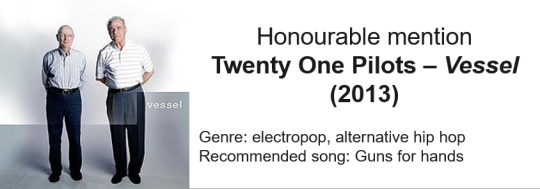
Early 21p may have never aimed to be cool, to avoid a certain appearance of lameness, but they did have a knack for writing some really catchy pop with an optimistic message. To the devoted, the critics of Pilots’ apparent mishmash of nerdy rap, sentimental piano balladry and EDM production were just stuffy, wanting music to stay how it was back-in-the-day forever and unwilling to get with the times. This viewpoint is understandable when you approach this album openly and actually listen to Tyler Joseph’s lyrics about youthful anxiety and insecurity, delivered with real conviction and sincerity, actually recognise that disparate musical elements are all there for emotional punch. A few songs do underwhelm. But this is emo for post-emo Gen Z’s and it’s easy to see why to some it can be deeply affecting.

The musical ancestor to the ongoing and endless stream of ‘lo-fi hip hop beats’ youtube mixes, chillwave filled the same low-stress niche, and Dive released at the peak of the genre’s relevance. Tycho’s woozy, mellow sound prominently features rich acoustic and bass guitar melodies over warm synths, enhancing the music’s organic feel compared to that of purely digital producers in the genre. The experience of starting this album is like waking up in a soft bed, the cover’s gorgeous sunrise reddening the room’s walls, while a guitarist improvises somewhere on the Mediterranean streets outside. And it is indeed great to study or relax to!

Simple, minimal acoustic guitar and vocals. If you’ve got talent this type of music shows it, or else it doesn’t: perfect then for Ichiko Aoba. Her touch is light, her songs calm, meditative, in no rush to get anywhere. As if serenely watching a natural landscape, one can best understand and enjoy Aoba’s music in quiet and peaceful appreciation.
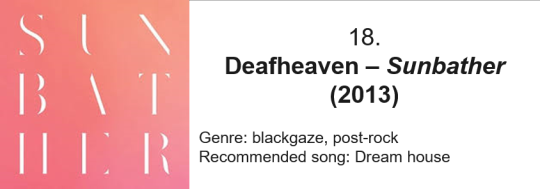
Through the incorporation of genres like shoegaze and alternative rock, Deafheaven managed to create a rare thing: a metal album that’s both heavy and accessible, needing no sacrifice of one for the other’s sake. Over these four main songs, there’s a sensation of being taken on an intense, atmospheric and even emotional journey, with the band stepping away from the negativity and misanthropy that dominates most metal. The vocals, closer to the confessionalism of screamo than classic black metal shrieks, express more sadness than they do aggression, and in respites between solid blaring walls of guitar and drums, calm pianos and gently strummed guitar passages set a pensive tone. This totally enveloping, flawlessly produced sound can take you away, like My Bloody Valentine’s best work, into a dream or trance.

By the late 2000s MCR had taken their thrones as the kings of a subculture formed from the coalition of goth, emo, scene and other assorted Hot Topic-donned kids, and earned a lifelong place in the hearts of many a depressed teenager. But after the generation-defining The Black Parade Gerard Way took off the white facepaint and skeleton costume, ditched the lyrics about corpse brides and vampires, and embraced an anthemic, purely pop punk sound. The silly story of Danger Days, set in a dystopian California where villainous corporations rule and only the Punks can stop them, serves as a kind of idealised setting for the all-out rebellion against authority and normality that so many fantasised about taking part in. The band’s electrifying performances are the most uplifting of their decade making music. For many diehards the upbeat sound here was a celebration that they’d made it through the most difficult years of their lives, and a spit in the face of those who’d done them wrong.
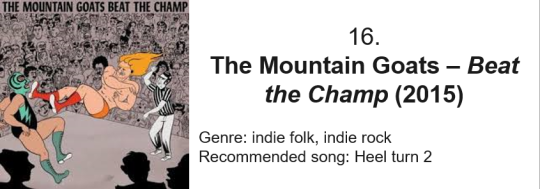
The teller of rural American tales, the indie legend, the teen-whisperer himself. John Darnielle, long past his early lo-fidelity home recordings and now backed by a full band, loses none of the heart his songs are famous for. The theme of the album, taken straight from John’s childhood when the pro wrestling on TV offered an escape from his abusive stepfather, is complemented by the country and Tex-Mex flavouring to the instrumentation. Some of the best lyrics in his long career infuse the stories of wrestlers with universal meaning - his characters try, fail, lose hope, reckon with their mediocrity, and when they step into the ring they’re up against all the adversity life can throw at them. John Darnielle’s saying that when that happens, you stand up and sock back.
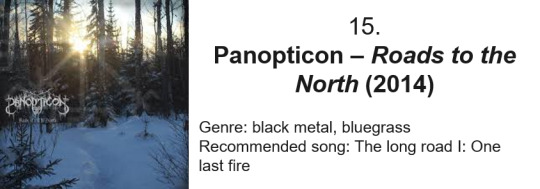
Folk music was always a major part of the Scandinavian black metal scene during its peak years, so when American musicians began exploring the genre naturally they incorporated American styles of folk. The complex, oppressive and sometimes hellish compositions here, starkly contrasted with bluegrass that sounds straight from the campfire circle, give the impression of life in the uncharted woods of the American frontier, in the middle of a brutally cold winter. Almost unbelievably, one-man-band Austin Lunn plays every instrument on the album: multiple guitar parts, bass and drums as well as banjo, fiddle, and woodwinds.
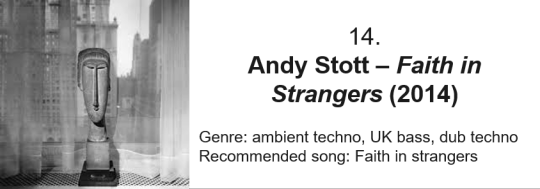
Andy Stott seems to delight in making his music as unnerving, haunting, perhaps even scary, as possible. The female vocals these songs are built around become ghostly, echoing and overlapping themselves disorientingly. The percussion, audibly resembling metal clanging, rustling or rattling in the distance, is often left to stand for its own, creating a tense space it feels like something should be filling. UK-based club and dub music can be felt influencing the grimy almost-but-not-quite danceable rhythms here, but the lo-fi recording and menacing vibe makes this feel like a rave at some sort of dimly lit abandoned factory.
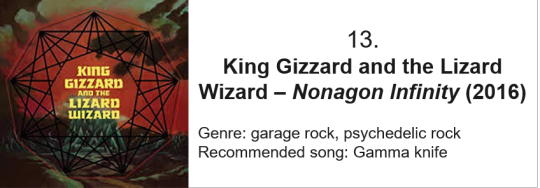
There’s so much Mad Max in this album you can just picture it being set to images of freights burning across the desert. True to its title, the nine songs on Nonagon Infinity roll into each other as if part of one big perpetual composition, with the end looping back seamlessly to the start and musical motifs cropping up both before and after the song they form the base of. With its fuzzy, raw sound, bluesy harmonica and wild whooping, the Gizz create a truly rollicking rock’n’roll experience. The band would go on to release 5 albums within twelve months a year later, but Nonagon shows these seven Australian madmen at the height of their powers.
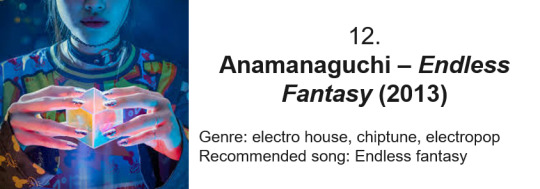
Sometimes you just want to listen to fun, hyperactive pop. The spirit of 8-bit video game soundtracks and snappy pop punk come together to create a vividly digital world of sound that seems to celebrate the worldliness, connectivity and shiny neon colours of early 2010s internet culture and social media. The up-pitched vocals and general auditory mania recall firmly Online musical trends like nightcore and vocaloid, while the beats pulse away, compelling you to dance like this is a house party and the best playlist ever assembled is on. It demands to be listened to at night with headphones, in a room lit only by your laptop screen.
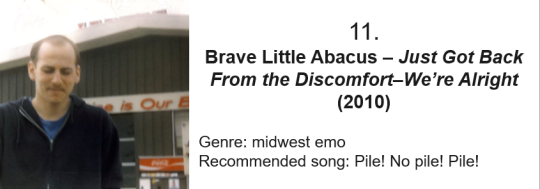
“You hate everyone. To you everyone’s either a moron, or a creep or a poser. Why do you suddenly care about their opinion of you?” “Because I’m shallow, okay?! … I want them to like me.”
The fact that that Malcolm In The Middle quote is sampled at the emotional climax of this record should give some idea to the absurdity that defines Brave Little Abacus. It’s not even the only sample from the show on here. And yet the passion and urgency so evident in Adam Demirjian’s lispy singing and the band’s nostalgia-inducing, even cozy, melodies are made to stir feelings. The tearjerker chords and guitar progressions are so distinctive of emo bands with that special US-midwest melancholia, and they are interspersed with warm ambiance and playful sound effects ripped from TV and video games, seemingly vintage throwbacks to a sunny childhood. Demirjian’s lyrics, yelled out as if through tears or in the middle of a panic attack, verge on word salad in their abstraction, but that’s not the point: you can feel his small town loneliness and sense the trips he’s spent lost on memory lane. The combined effect all adds to Just Got Back’s themes of adolescence and the trauma of leaving it. While legendary in certain internet communities for this album and their 2009 masterpiece Masked Dancers, the band remains obscure to wider audiences.

These Danish punks know how to convey emotion through their raw and dramatic songs. Elias Rønnenfelt’s vocal presence and charisma cannot be ignored: his husky voice drawls, at times breaks, gasps for breath, builds up the deeply impassioned, intense force behind his words. The band sounds free and wild, unrestrained by a tight adherence to tempo, often speeding up, slowing down or straying from the vocals within the same song, as if playing live. Instrumentally the command over loud and quiet, tension and release, accentuates the vocals in crafting the album’s pace. Horns and saloon pianos throughout give the feel of a performance in a smoky, underground blues bar, with Rønnenfelt swaying onstage as he howls the romantic, distraught, heartbroken lyrics he truly believes in.
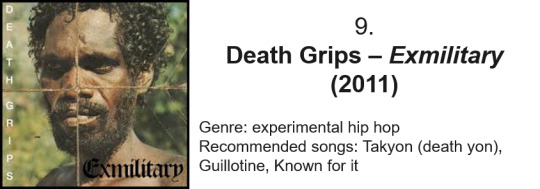
At some point on first listening to Death Grips, a thought along the lines of “He really yells like this the whole way through, huh?” probably crosses the mind. When Exmilitary first appeared, quietly uploaded to the internet, the rapper’s name and identity unknown, another likely reaction among listeners might have been “What am I even listening to?” But perhaps more revolutionary than Death Grips’ incredibly aggressive sound and style might have been its foreshadowing of how over the next decade underground rap acts would explode into the mainstream through viral songs, online word of mouth and memes. It showed all you needed to come from nowhere to the top of the game was to seize attention, and it did that and far more. MC Ride’s intoxicatingly crass, intense rapping captures the energy of a mosh pit where injuries happen, the barrage of sensations of a coke high, while the eclectic mix of rock and glitchy electronics on the instrumentals is disorienting in the best way. If rap were rock and this was 1977, Death Grips would have just invented punk. Ride’s lyrics paint a confrontational, hyper-macho persona; unlike much hip hop braggadocio, the overwhelming impression given is that Ride truly does not care what anyone thinks. He just goes hard and does not stop. It’s music to punch the wall to.
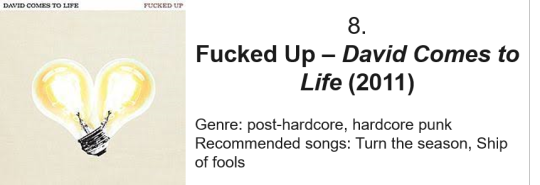
Inspired by classic rock operas, this concept album represents some major ambition and innovation in musical storytelling. Delivered in frontman Damian Abraham’s gravelly shouted vocals, the complex lyrical narrative of the album follows a factory worker, an activist and their struggle against the omnipotent author (Abraham himself) who controls their fates. Featuring devices like unreliable narrators and fourth-wall breaking, it takes some serious reading into to untangle. But it’s the bright guitarwork, combining upbeat punk rock and indie to create some killer riffs, that gives the album its furious energy and cinematic proportions.
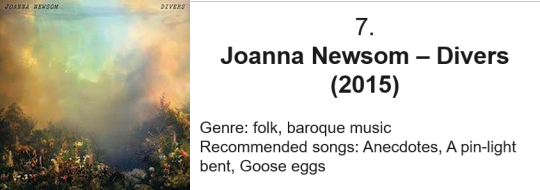
Joanna Newsom is enchanted by the past. Like 2006’s ambitious Ys, the music on Divers makes this evident with its invocation of Western classical and medieval music, throwing antiquated instruments like clavichords together with lush string orchestration, woodwinds, organs, folk guitar and Newsom’s signature harp. With her soulful, moving vocals leading the way, it’s hard not to imagine her as some kind of Renaissance-era country woman contemplating nature, love and mortality in the fields and the woods. As always Newsom proves herself a stunningly original and creative arranger with the sheer compositional intricacy and flow of these songs, and most of all the harmonious intertwining of singing and instrumental backing.

Burial’s music is born from the London night: the bustle of the streets, the faint sounds from distant raves, the buskers, the rain on bus windows. This EP’s dreamlike quality makes listening to it feel like taking a trip across the city well after midnight, watching the lights go by, with no idea where you hope to get to. Every single sound and effect on these two songs is so precisely chosen, from the shifting and shuffling beats, the swelling synths and wordless vocals that sound like a club from a different dimension, the ambient hiss and pop of a vinyl record. Musically this sound is drawn from UK-based scenes like 2-step and drum ‘n bass, but twisted into such a moody and abstracted form as to be nearly unrecognisable as dubstep. Just when this urban, dismal sound is at its most oppressive, heavenly soul singers or organs cut through like a ray of light in the dark.
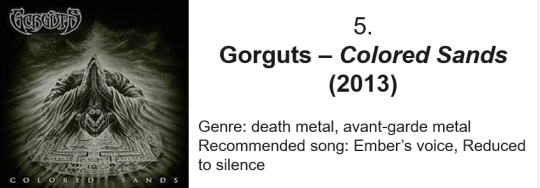
There’s an imaginary rulebook of how construct music, how to properly make tempos and combinations of notes sound harmonious, and Gorguts have spent their career ripping it up and throwing it in the bin. On 1998’s seminal Obscura, their atonal experimentation sounded at times like random noises in random order. But listen closely to Obscura or Colored Sands, their return after a long hiatus, and the method behind the madness emerges. One mark of great death metal is that it’s impossible to predict what direction it will go even a few seconds in advance, and the band achieves this while presenting a heavy, slow, momentous sound. The density of inspired riffs, and the intricate balancing of loud and quiet, fast and slow paced throughout these songs are exceptional. In instrumental sections the guitars will echo out as if across a barren plane, then the song will build up to the momentum of a freight train. Behind the crashing and twisting walls of guitar the patterns of blast beat drumming are almost mathematical in nature. Luc Lemay’s harsh bellows sound like a warlord’s cry or a pure expression of rage to the void. It’s threatening, menacing, unapproachable, but it all makes sense in the end.

Futuristic yet deeply retro, Blank Banshee’s music takes vaporwave beyond its roots in the pure consumerist parody of artists like Vektroid and James Ferraro and makes it actually sound amazing. Songs are built out of a single vocal snippet processed beyond recognition, new agey synthesisers, Windows XP-era computer noises, hilariously out of place instruments, all set to the 808 bass and hi-hats of hip-hop style beats. The genre’s pioneers intentionally sucked the soul from their music using samples pulled from 70s and 80s elevators, infomercials and corporate lounges - here the throwback seems to be to the early 2000s childhood of the internet, and the influence of a time when email and forums were revolutionary can be felt. The effect of this insanity is an album that whirls by like a techno-psychedelic haze: the atmosphere of dark trap beats places you squarely in a 2013 studio one moment, the next you’re surrounded by relaxing midi pianos and humming that a temple of new age practitioners would meditate to. Still, at some point when listening to this album, perhaps when the ridiculous steel drums kick in near the end, you realise that this is all to some degree a joke, and a funny one. It’s hard to overstate what an entertaining half-hour this thing is.

While 2012’s Good Kid, m.a.a.d City presented a movie in album form of Kendrick’s childhood and early adult years, TPAB’s journey is one of personal growth, introspection, and nuanced examination of the state of race in post-Ferguson America. It’s simultaneously the Zeitgeist for the US in 2015 and a soul-search in the therapist’s office. Sounding deeply vulnerable, he openly discusses depression, alcoholism, religion and feelings of helplessness. The White House and associated gangstas on the cover give some idea to the album’s political themes, with Lamar contrasting Obama’s presidency to the political powerlessness and lifelong ghetto entrapment of millions of black Americans. Everything I’ve written about the lyrics here really only scratches the surface because the words here are substantive, complex and dense with meaning. Near enough every bar can be analysed for multiple meanings and interpretations, essays can and have been written on the overall work, anything less does not do justice. The musical versatility on display is astounding: the album acts as an extravaganza of African-American music, from smooth west coast G-funk to east coast grit, neo-soul and rock to beat poetry, and most of all jazz. Like an expertly laid character arc the record progresses through its ideas in such a way that they’re all impactful, with the slurred rapping imitating a depressed drunken stupor followed later by exuberant, defiant cries of “I love myself!”, the white-hot rage against police brutality balanced by the hopeful mantra: “do you hear me, do you feel me, we gon be alright”. Perhaps the most culturally significant album of the 2010s and an essential piece of the hip-hop canon.
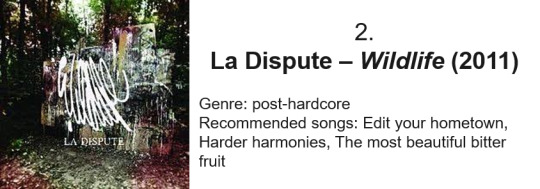
This harrowing hour chronicles the struggles and everyday tragedy of a series of characters and their relationship with the city they live in, narratively driven by some outstandingly poetic lyrics. Jordan Dreyer’s wordy tales despair at the poverty, gang violence and urban decay in the band’s native Grand Rapids, Michigan, an almost childlike open-hearted naivete in his words as he empathises with the broken and alienated people in these songs. There’s no jaded sneer or sly lesson to be learned as he sings about the child killed by a stray bullet or the homebird left alone after all their friends move away, just genuine second-hand sadness and a dream that compassion and community will eventually heal the pain. Taking elements from bands like At the Drive-In’s fusion of punk and progressive, and mewithoutyou’s shout-sung vocals, La Dispute hones its sound to a razor edge to put fierce instrumental power behind the lyrics. Not an easy listen, but a sharply written songbook and a perfect execution on its concept.
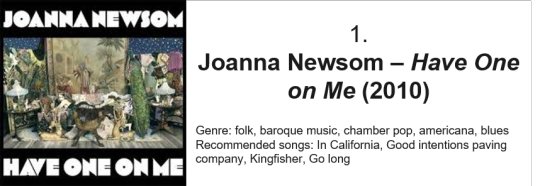
Around 2008, Joanna Newsom met comedian Andy Samberg. Within a year, their relationship was becoming the basis upon which the poetry of Have One on Me was spun. Newsom’s lyrics, exploring her relationship with her future-husband, nature, death, spirituality, are above all else loving. Through her warm and vibrant voice, at times an operatic trill and in others deeply soulful, she expresses the joy of love for another, the peace and earthly connection of her beloved pastoral lifestyle, deeply affecting melancholy and grief. Contemplative, artful, genuine or expressive: every lyric in every sweet melody is used to offer her ruminations on life or overflowings of passion.
More so than her previous and next albums, the feel of the album is of not just a folkloric past but also the present day, with drums, substantial brass and string arrangements, and even electric guitar anchoring the sound to Newsom’s real, not imaginary, life in the 21st century. Yet songs here with moods or settings evoking simpler lifestyles and the women living them in 1800s California or the Brontës’ English moors still have a universal relevance. Whether rooted in past of present, the instrumental variety of these compositions, from classical solo piano, grand orchestral arrangements led by harp, to the twang of country guitars or intricate vocal harmonising, makes it apparent that this is the work of a master songwriter in full command of well over a dozen talented musicians. Ultimately, what makes this my favourite album of the decade is that, very simply, it is one stunningly beautiful song after another, all collated into a cohesive 2-hour portrait of Newsom’s soul.
4 notes
·
View notes
Text
Petition for UK Cinemas to provide better captioning.
For those of you who are not aware, UK cinemas very rarely show films with subtitles (Closed Captioning) at times suitable for most people who need them. Often the theme is that “subtitles are ugly!”, and “well, very few people ever come to see these subtitled showings, so what’s the point in making them more frequent/accessible?” (Uh, did you consider that no-one is ABLE to get to these showings?).
Open the read more to learn about this situation.
Disclaimer: I’m neither deaf or hard of hearing. I struggle with hearing some things, but I am Hearing. Please let me know if any of my wording is incorrect. Additionally, I am someone with sight. If my image ID’s could be improved, please do inform me.
TL;DR: Cinemas do not provide appropriately timed captioned showings of films. Please show support for caption-needing people by signing this change.org petition [link] created with the intention of encouraging UK Cinemas to correctly cater to the D/deaf and hard of hearing, as well as those with English as a Second or Foreign Language, sensory issues, or processing disorders.
A list of links to the sources I’ve used in-line is also available at the end of the post for accessibility.
Here’s some examples of films having little to no subtitle showings in UK cinemas, from two Cineworld cinemas I visit frequently:

[Image Description: A list of the showing times for Fantastic Beasts: The Crimes of Grindelwald at Ashford Cineworld cinema on Sunday 18th November. The only time listed with subtitles is 14:50. There are twelve 2D showings and five 3D showings of this same film on the same day, without subtitles. End description.]

[Image Decription: Another list of the showing times for the same film at the same cinema, Monday 19th November. The only time listed with subtitles is 17:10. There are, again, twelve 2D showings and five 3D showings of this same film on the same day, without subtitles. End Description.]
The Ashford cinema has 12 screens. These showings are during the first week of this film’s release (The film came out today, Friday 16th November). On the Sunday, there are a total of 15 films being shown. On Monday, there are 11 films in total.
Now, let’s look at Dover:

[Image Description: A third list of showing times for Fantastic Beasts: The Crimes of Grindelwald at the Dover Cineworld cinema, Wednesday 21st November. The only time listed with subtitles is 16:10. There are 4 2D showings and one 3D showing of this same film on the same day, without subtitles. End Description.]
Dover Cineworld is a 6 screen cinema. Again, this is the first week of this film’s release. This one subtitled time-slot is the only one this cinema has in the first week. This cinema is showing 6 films on Wednesday 21st.
Every single showing at these two Cineworld cinemas (I’m not sure about other ones) has Audio Description via a headset given to those who request one.
Here is what the Cineworld website likes to say about Audio Description:

[Image Description: Part of a screenshot of the Cineworld website, listing the features of each cinema. Audio Described is shown, with a tooltip that reads “Special service for blind and visually impaired cinema goers which doesn’t affect other spectators”. End Description.]
This implies that subtitles are “affecting” hearing people, or those who don’t need subtitles for other reasons, hence why captioning is not available in every single showing, or at least, a larger percentage.
The issue with these times is that they are largely unreasonable for both deaf adults and deaf children. Primary and Secondary schools in England let up around 3pm, sometimes 4pm. College is usually 9-to-5. Work is also 9-to-5 for many people. The times given in the first week of release - 2:50pm, 4:10pm, and 5:10pm - are really unacceptable and inaccessible for deaf people who work or are in education.
As is the ableist society we live in, there will always be people who legitimately believe Open Captioning - captions which are fixed on the screen and cannot be removed by the viewer - is ugly and unnecessary. There is however, a call for cinemas to cater better to their caption-needing patrons.
I just finished watching a video by the wonderful Jessica Kellgren-Fozard [@jessicaoutofthecloset - Tumblr] who brilliantly explains her experience as a deaf girl and cinema-goer [Click to view], in which she also provides a link to a petition created by Deafie Blogger [Twitter link] to encourage UK cinemas to show more appropriately timed viewings with captioning. This petition [link] is important as the result will be that films will be more accessible for more people. Jess suggests in her video one “appropriately timed” showing with captions a week, but I feel we could do a lot better than that.
Jess also mentioned “caption glasses”, which I decided to research. It would seem that the National Theatre (which hosts stage performances) has begun using a Google Glass looking headset which shows Closed Captions to individuals, rather than Open Captions to the whole audience (which would be a bit tricky with stage performance). I would like to see this technology being implemented in cinemas, and my interest is particularly piqued by the fact that I’ve not seen cinemas look into this technology which “wouldn’t affect” other viewers, since they - Cineworld at least - seem to tout that the Audio Description headsets’ non-invasive use is one of its best features.
The reason that this is an issue because The Equality Act 2010 states that:
“The Equality Act 2010 covers all service providers in all sectors, which means you must do what the equality law states in relation to your staff training and awareness, operational functions, processes, information and facilities. In order to do this, you may need to make some reasonable adjustments, which means possibly changing the way things are done, providing aids and additional services and making changes to overcome barriers created by the physical features of your premises. What is considered reasonable in law depends upon the effectiveness of the change, the building’s status (e.g. Listed Building) and the physical practicalities and financial implications.”
If we specifically compare the phrases I bolded -“reasonable adjustment” and “providing aids and additional services” - with the evidence of very few subtitled screenings and no assistive aids for non-subtitled screenings, alongside the express opinion of the D/deaf community, we can infer that what cinemas currently do, does not completely satisfy this element of The Equality Act 2010. This petition intends to encourage cinemas to be more open and inclusive, tending to their disabled patrons more efficiently, as well as prompting them to listen to the voices of the disadvantaged.
Thank you for taking the time to read this post.
List of links:
Petition link: http://bit.ly/2QwzgXv.
Cineworld: http://www.cineworld.co.uk.
Jessica’s video: https://www.youtube.com/watch?v=6NP4kAPdgTQ.
Deafie Blogger’s blog: http://www.deafieblogger.com.
Deafie Blogger’s Twitter: https://twitter.com/deafieblogger.
National Theatre’s Caption Glasses: https://www.nationaltheatre.org.uk/your-visit/access/caption-glasses.
The Equality Act 2010, gov.uk: https://www.gov.uk/guidance/equality-act-2010-guidance.
5 notes
·
View notes
Text
Questions from Maiana Minahal’s Students in English 272, “Filipino Women Writers”...My Responses
Dear students and readers,
I’m honored that you’ve read my work and are interested in these facets of my life and craft as an artist. I love the challenge of being given questions to write about. So, here goes!
1. What is the best thing that writing, performing, creating, etc. provides you? It seems you have many talents, how do each contribute to the person that you are? What do you love about each?
I’ve combined a couple of similar questions here. First, thanks to whomever has said that I have many talents; I’m flattered. I do believe I was blessed with a variety of areas of interest and natural “talent” that I got to explore and develop in different phases of my life. I even felt split about whether to respond to the questions in writing and using my voice and image (because I love storytelling and the voice).
First, what do I love about writing? And perhaps writing, as opposed to performing or creating other kinds of multidisciplinary art (plays, collaborations with dance, music, etc)?
Writing is most private; it’s also a place for confession because in many ways, it’s hidden, is behind a mask. Writing can be on one hand too analytical, but when it’s the most powerful it can also be magic-making, enabling a metaphor to be developed and breathe, an image to vibrate and have scent and color; a scene and characters to come alive with dialogue, backstory, and motivation. It’s a place of invention, slower invention that has no immediate impact except itself on the page - as opposed to live performance which is more of an improvisation and collaboration together with an audience.
Performance, then, is that other thing; I believe performance happens on the page, in that invention, as well, but if we’re talking about performing on the stage or at a microphone, it’s a collaboration among many elements: space (architecture, weather), time, other people / audience, circumstance. It’s also very natural, an ancient throwback to the griots and oral historians and singers and spiritual leaders making incantations...it predates writing. The body is a vessel with so many faculties, and this is the most exciting set of possibilities. Should this line or this word be whispered? Yelled? Projected on the body? Who is my audience when I perform? Are you my audience? Is my audience in the past, present or the future? Am I in the past, present or future? What am I able to bring to life right now, and even co-create with you a new circumstance within the present moment? In theater and in poetry, even if it’s the same exact play or the same poem, each rendering is unique. Did someone laugh at a different part? Did someone cry? Am I feeling the spirit of my grandmother that day? Or my future child? Also, the voice is vibrational. There’s a way in which, when we perform, we are contacting others through the voice, through the heat of our bodies; we share a space and time that never occurs again.
Creating multidisciplinary work - I’ll differentiate as projects that are collaborative, that may involve production elements such as video-poems, dance theater, or collaboration with musicians and filmmakers: this takes the Performance and the Writing to another level. Now, let’s add other people who are experts in their own fields: choreographers, dancers, composers, emcees, filmmakers. I have had the opportunity to work with a variety of these, in making projects such as a “Tiny Fires” poem collaboration (click for excerpt) with San Francisco State University’s Dance Theater, in which my poem was translated into choreography and the dancers learned all of the lines; a recent collaboration with Alayo Dance Theater called “Manos de Mujeres” in which I researched, interviewed and wrote about the lives of Cuban Women and the dance company danced and choreographed to my words; a recent project called “Water and Walls” (click to watch) in which we all wrote verses to music about a shared theme and a filmmaker worked with us to produce a video. These are all exciting ways for the writing to live and breathe and thrive in different ways, through different mediums. When it comes to plays, I do not even perform in the work, but get to see talented actors bring the stories to life, with directors at the helm and production crew helping execute a vision. It’s like giving birth...and seeing someone grow up beyond you, doing things you could not do...
2. What are some influences on your poetry/work? (I reworded this one somewhat; I hope it is still fine!)
I think I’ve answered some of this in the above, in a way. I am influenced by many art forms, and can’t see it any other way. I’ve never sat well with only poetry or only words, which can be limiting, and often, as referenced earlier, can become too cerebral. Words are meant to be released, like songs are meant to be sung. I am influenced by my early exposure to playing piano and dancing ballet, and later playing percussion and dancing West African and Afro-Cuban and Salsa and a slight bit of Filipino movement. I am influenced by the work I love to watch - other theater-makers, poets, dancers. Music influences me deeply, and often I hear poems come to me like strains of music, with melodies and rhythms. The natural world influences me. And history. As you have seen in my book, I can get nearly obsessed with history. The way it was written, the way it omits, the glimpses it gives us into the minds of people. Who is heard and who is not; who is rendered silent in the writing; who needs to be heard, if even in imagination. History excites me and leads me to get possessed. Lastly, change-makers and activists, because I came out of that. I first wrote most fiercely and performed my first spoken word poems because I wanted to tell the story of a little girl, Crizel Valencia, who died at age 6 of leukemia after growing up on a toxic wasteland left by the United States military. I lived in her community and in her home and we drew together. When she died, after making dozens of drawings of herself envisioning her community and her own survival, I felt possessed to write, and speak. So, spirits influence me too.
3. About the book, SOUVENIR: What was the inspiration behind the layout and style of your poems? For example, the use of different fonts and inclusion of outside texts like in your poem "Manifest Destiny 1980." I really liked how you wrote and organized your book by using exhibits (like in the museum, there's a story for each object or subject) I find it very creative. What gave you this idea or how did you think of it?
Each poem definitely has its own inspiration, but I can focus on the one you mentioned, first. In “Manifest Destiny 1980″ I was basically writing parallel realities - one in 1980 (my own personal story of migration across the country) and the one in 1803 of the Lewis and Clark Expedition - both which moved from East to West. In mapping out my own family’s road trip from New Jersey to the small Tri-Cities (Pasco, Kennewick, Richland) towns of the Pacific Northwest, where I remembered growing up with stories about Lewis and Clark and Sacajawea, I found that we followed similar route as Lewis and Clark. But, while our trip and our experience was about immigrants and their daughter adjusting and assimilating to White America, Lewis and Clark went to study and exploit the knowledge and resources, and the environment, of Native people. We were subjected to being analyzed and studied and ostracized; they were, as well, but in the end were in the position of power linked to the destruction and removal of local people. The parallel in the layout was meant to enable the two readings (top to bottom) and also one interrupting the other.
As for the exhibits: as you probably know, the 1904 St. Louis World’s Fair (Louisiana Purchase Exposition) celebrated the 100-year anniversary of the Louisiana Purchase, which followed the Lewis and Clark Expedition. In the 1904 Fair, Filipinos were displayed in living exhibits, forced to re-enact rituals (at far too many intervals, unnaturally, for show and even competition), eat, sit, and interact in the public eye, as the living conquests of the US Imperialists. I realized that so much of our lives was and is performance as well - my parents needing to demonstrate their ability to work and function within the American context; my striving to fit in, disappear, or perform as the rare Filipino girl in often non-diverse environments. Without being too literal, I was interested in how we can see our lives on display, and what is lost or gained in that performance. And objects - what are the objects that are collected as treasures of war - including our own bodies?
4. In the poem, "My Mother's Watch,” did that situation really happen to you? If you do go back to the motherland regularly, does the profiling still happen to you today?
Yes; that poem is actually pretty true to life. I wouldn’t have called it “profiling” in that I think that term carries meanings of power within a racist context such as the United States. In the Philippines, it was more of curiosity, more of realizing that you could never really “go back” in a way that is simply nostalgic or “authentic” -- that once the departure from the homeland, and the living within the United States context occurs, we may appear similar in skin and features, we may be 100% the same as our relatives in some ways, but we are not because we have lost our native tongues, or cultural norms, or gestures. And also - that I felt so much bigger and taller than other Filipinos speaks to the fact that many of our own relatives or people just like us back “home” had access to fewer resources and nutrition, whereas we were able to grow up on milk and in my case, packaged and microwaved foods. Even in our bodies, we are altered forever. There was an article/ interview about this poem here that may be of interest: http://www.lanternreview.com/blog/2011/05/31/process-profile-aimee-suzara-discusses-my-mothers-watch/
5. What was the hardest part of the book to write?
The whole thing was hard to write, but it was actually harder to write the “colonizer”/white man/government/military and scientific voices because they were so emotionless at times, so declaratory, and in many cases, so condescending, if not overtly racist. To dwell in the language in which Filipinos were called “niggers” and “rabbits” and that torture of Filipinos seemed to be so much fun; or that Native and Filipino and Black people’s skulls and genetics were inferior (according to the scientific racism of the time); and also that so much of it seemed to ring true to today. It’s much easier to write personal narrative, lyrical narrative.
6. What do you hope for readers to remember the most?
I hope that readers can see themselves reflected in the glass of the museum exhibits. That regardless of their background, they see how Filipino-American History is American History and not some niche piece of history, but actually demonstrated some of the most egregious cases of scientific racism and exploitation, the epitome at the end of the 19th century, of colonialism and imperialism. I hope readers check out more of the history, and also reflect on themselves and where they come from.
7. What is the most nerve wrecking thing about becoming a mother for the first time? (Congratulations by the way!)
I put this at the end because it feels, in a way, like a bonus question, but also something very relevant to our lives as artists. Becoming a first-time mother involves putting everything aside - my writing, my teaching, my projects - in service of my health and the health and protection of the child I am going to birth. I have birthed many other things: projects, plays and poems, but a human being -- this requires the most sacrifice and faith I’ve ever had to summon. At the same time, I think it’s very important for you, readers, to know that as artists, our lives are our art, just as art is our life. We never stop being one or another (people, mothers, playwrights, performers). If I believed I would stop being an artist, I could despair, but if I were to stop being an artist, what kind of mother would my son have? He deserves my full self. So, while our time becomes more limited and we have to focus on the child, we do not lose ourselves; we simply change.
Thank you for your interest and I hope you’ve enjoyed my answers!
1 note
·
View note
Photo
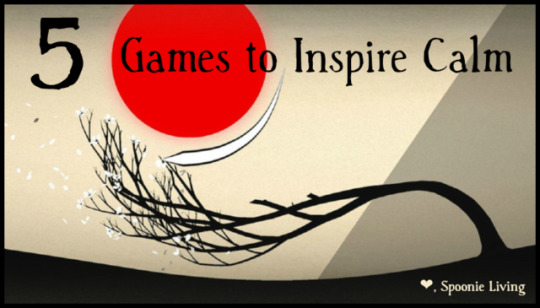
[Image: a digitally-created “ink brush” painting featuring a tree bowed by the wind, petals flowing from its branches, on a beige backdrop with a bright red moon.]
5 Games to Inspire Calm Chiara Scotellaro, The Millennial Patient
Are you looking for an activity to help you achieve calmness in your day? Something that you can incorporate into your self-care routine which is always within reach?
One of my favourite methods of bringing calmness into my day is through games and apps, which are a readily accessible solution as I always have my phone within arms reach. I regularly use games and apps as part of my self care and mindfulness routine. Below the cut are 5 games that help me relax and bring me tranquility if I’ve been feeling stressed or restless.
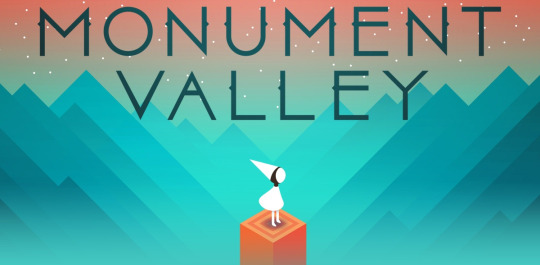
[Image: a modern stylized landscape of blue mountains against a starry sky. “Monument Valley” is displayed across the top of the image, and a white figure in pointed hat and dress stands atop a pedestal.]
Monument Valley
Monument Valley is a beautifully designed atmospheric puzzle game developed by Ustwo Games. The gameplay consists of helping princess Ida through an Escheresque maze which shifts and morphs around her. And thanks to its beautiful artwork, playing Monument is like walking through my favourite drawings.
Puzzle games normally chew up my spoons, so the best part of this game is that the less I try to think of a solution, the more likely I am to solve the puzzle. Playing Monument Valley is more about clearing my mind and exploring. It’s perfect for when I’m tired but want to do something a bit more engaging than watch tv.
This is a great puzzle game if you have cognitive fatigue and a fun approach to mindfulness.
Monument Valley on iTunes Monument Valley on Google Play

[Image: a silhouette of a small, thin tree on uneven terrain, all black against a beige sky with a bright red moon peeking down from the top. “prune” is written between tree and moon.]
Prune
Prune is a pretty and wonderfully minimalistic game by Joel McDonald where you cultivate a tree to grow in certain directions so it can reach the light. You do this by pruning branches with a swipe of your finger; then you watch it grow in hopes it will flourish in the light of the sun.
I love this game because I love bonsai, but the real thing never lasts long in my care. This game is my pocket bonsai and my alternative to pottering in the garden for relaxation. Just like Monument Valley, it promotes exploration and helps clear my mind. There is no need for overthinking—if I just play and vary my approaches, the solution will come.
This game is perfect for when you just want a few minutes of quiet, and it’s ideal for waiting rooms at the doctor's office!
Prune on iTunes Prune on Google Play
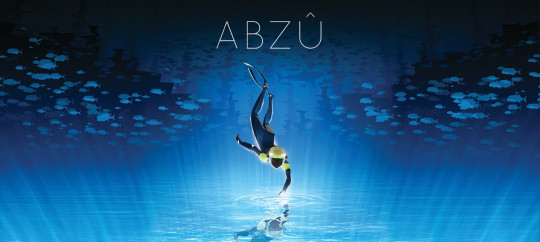
[Image: an undersea scape with schools of fish in the background. A diver is swimming downward and touching a reflection of themself in what appears to be the top of a (second) body of water. “Abzû” is displayed in thin letters at the top.]
Abzû
Abzû is described as an adventure art video game developed by Giant Squid Studios. However, for me, Abzû is more of an experience than a game.
In Abzû, you are a diver exploring the ocean and restoring life through the use of magical springs. I get to explore various underwater environments, swim with whales, ride a turtle, or just meditate on a rocky outcrop and watch the aquatic life swim around me. It’s quite short, and the puzzles may seem simple, but it just feels amazing to play. I only wish I could play the VR version next time.
This game really fills my need for new experiences when I’ve been housebound for too long. It’s the next best thing to visiting the aquarium and the closest thing to going diving as I can get at the moment. I just love love love this game!
Abzû on Steam
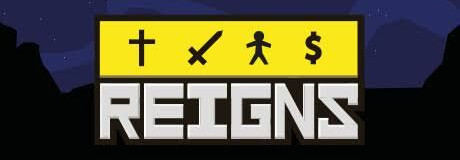
[Image: on a background of mountains and a night sky, a logo with a band of yellow at the top and four icons: a cross, a sword, a person, and a dollar sign. “Reigns” is displayed below this in gray, angular block letters.]
Reigns
Reigns is a text-based game developed by Devolver Digital in which you play the role of a medieval monarch. Gameplay is super simple and consists of storyline cards which ask you to decide between two choices. You make your decision by either swiping left or right (sound familiar? 😉). The choices you make will determine the fate of your monarchy as well as those you rule. You play through many reigns—some spanning decades, others barely lasting a day.
Unlike the other games in this list, the theme of this game isn't the calming element here, in fact, this game has a lot of dark humour in it. For me, the calming aspect here is the gameplay, it brings me calm through distraction. What I like most about Reigns is that gameplay is very short, your monarch's reign can often last only a minute or two. It also doesn't require much concentration or logic because there's no way of predicting the outcomes of your choices.
For me, Reigns is a brain fog friendly alternative to puzzle games and another great game to play in waiting rooms. I just swipe left or right and await the next twist in the story.
Reigns on iTunes Reigns on Google Play Reigns on Steam
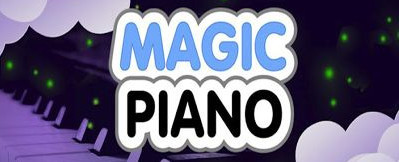
[Image: “Magic Piano” written in sky blue and black bubble letters against a background of a keyboard, clouds, and abstract green lights.]
Magic Piano
Magic Piano by Smule allows you to play your favourite piano music on your phone or tablet. Music is one of the most effective ways for me to find calmness and joy. And playing the music yourself, just like dancing or singing, elevates the whole experience. Magic Piano makes playing music accessible by showing me the notes to play.
Despite having no musical ability and limited dexterity in my fingers, I can still play along with my favourite songs on my tablet. I can also change the difficulty depending on the stiffness of my hands. Much like Guitar Hero, it allows me to live out my rockstar fantasies despite my complete lack of skill. My favourite thing to do at the end of the day is play Moonlight Sonata to slow things right down.
Word of warning with this game: I started experiencing vertigo a while ago, and the scrolling colours began to trigger headaches. I’ve had to stop playing it as a result. If you have similar problems, you might want to give this one a pass.
Magic Piano on iTunes Magic Piano on Google Play
These games are a regular part of my wind-down time and have provided me with varied options to creating calm in my day. Just like music, a cup of tea, or a warm bath they help me transition from busyness to stillness. They provide me with just enough escapism to help me let go of the day's problems and get into a different mindscape, but are not so utterly engrossing that I lose hours to gameplay.
If you have games or apps that help you achieve calmness, then please feel welcome to share your recommendations in the comments or via a reblog!
Chiara Scotellaro was diagnosed with Multiple Sclerosis in 2011 and has dedicated her time to helping others learn how to manage life with a chronic illness ever since. An experienced Mental Health peer worker, she has helped others in their recovery journeys by sharing her knowledge and experience on navigating life’s challenges with a chronic illness.
You can check out more of her work at her blog, The Millennial Patient, or follow her on Twitter @PatientGenY.
#spoonie#chronic illness#disability#invisible illness#chronic life#games#ios#android#steam#entertainment#calm#calming#mindfulness#brain fog#arthritis#housebound#gardening#contributor
356 notes
·
View notes
Photo

Interview with Visual Artist Adrian Wojtas.
Tell us about yourself.
My name is Adrian Wojtas and I’m a multidisciplinary creative working with photography, design, and film. I just turned 22. I'm originally from Nawojowa, Poland. I moved to Ireland in 2006 and I’m currently based between Navan in Co. Meath, and Dublin. For the past four years I studied Photography at IADT and I’ve recently graduated with First Class Honours.
In your opinion, do you need education to become a photographer?
For me,studying Photography at IADT has really opened my eyes in terms of critical thinking, really digging deep and engaging with material, which in turn has an impact on the work I produce. Besides the technical stuff -which you can teach yourself in your own time - I think one of the main benefits of art college is being in the creative space where you meet like-minded individuals. You gain and shape an understanding of the world based on the content that you and your peers engage with.The discussion, critique,and awareness of what’s out there is important to your development as a creative. I’m all for it.
I think college really helped me with critical thinking. It gave me the experience and a methodology for how to look at things and how to really engage with them. I know people who didn’t go to college or study photography academically that have gone to be successful, but I still think a degree is a great thing to have. A degree shows that you’ve put in the effort, suffered through the four years, and you achieved something. There are years of experience and work behind that piece of paper.
What have you learned in college that you apply to your work today?
Attention to detail. That and understanding the importance of preparation, presentation, and professional practice.
Influences?
I like to branch out and draw on inspiration from a wide variety of mediums and genres. Some of the main resources would be film and cinematography, painting, illustration, other genres of photography, and even written work from novels to non-fiction. Whatever works!
How would you describe yourself as a photographer?
Photography isn't the only medium that I work with so I wouldn't call myself strictly a photographer. Aside from photography, I also work with in graphic design, film, and cinematography so I’m open to working on a multitude of different projects.
You’ve recently directed your second short film, More Than This. What is it about?
In a nutshell, it’s about somebody finding out a certain truth about their environment, and how they come to deal with their newfound knowledge.The film touches up on themes of isolation, bureaucracy, and memory. It was a fine exercise in world-building and one of the important aspects in the beginning of production was that we wanted it to have a surreal and otherworldly quality. Colour plays a key role throughout the film and the art direction of the set and graphic design have had a huge impact upon the believability of the world of the film. Being a predominantly silent film, it was important that the cinematography drove forward the feeling of uncertainty and tension. In addition, the film’s score added another layer to the discomfort by giving it a creeping and unsettling tone. The work of Roy Andersson, Wes Anderson, and David Lynch have been some of the primary influences on the film.
As it was a student film and a micro-budget self-funded production, the crew and our resources were quite limited. The restrictions in budget also meant that we had to get creative. Several locations in the film had to be faked and reused as new with set redressing and changes in camera position. Some of the crew had to take on additional roles while on set. It also involved a lot of learning for me personally since it required various bits of VFX to be added in post-production. A lot of the production came down to preparation yet again, from recon shoots right down to managing people’s schedules.
The film stars David Dooley, who’s also played the lead in my first and previous short film a short film about filing. It was directed, shot, produced, art directed, and edited by me, and written and co-produced by Kieran Murray who was also involved in the previous film. Orlaith Darcy and Danilo Zambrano have worked on the sound design, Amy Lawless did the make-up, and my brother Mateusz Wojtas designed and made our props.
The film has done quite well so far and has been Long listed for the RDS Visual Arts Award as well as Highly Commended in the Inspirational Arts Photography Award last year. It’s also screened at film festivals in Cork and Kerry in Ireland, as well as Toronto in Canada. It’s set to screen at this year’s River Film Festival in Padova, Italy this June.
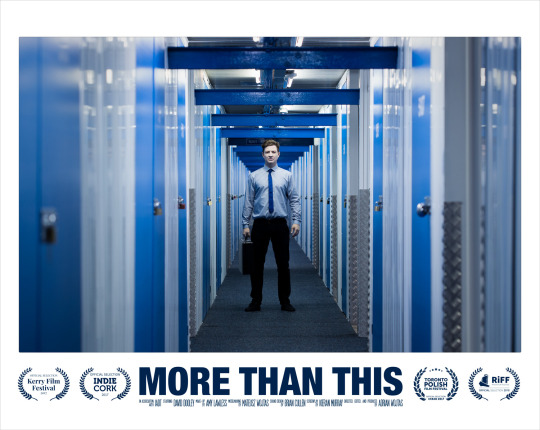
Tell us a little about your upcoming cookery book project, Smakołyki.
It’s still very early days in the production process but it’s coming along nicely. Smakołyki: The Art of Traditional Polish Baking is my upcoming cookery book of traditional homemade Polish baking and desserts, with recipes written and developed by my mother, Anna Wojtas. The project started out as one of my two graduate projects during the final year of study at IADT (the other being the film, More Than This). The idea for the project arose from an interest in revisiting my roots and learning more of my heritage. Since moving away from my homeland, the traditional food my family makes has remained mostly unchanged. This has been one of the key elements responsible for preserving my cultural identity abroad.
During my final year in college I designed and photographed a small cookbook featuring ten recipes. The current plan is to expand on that and develop the book into a full sized tome of recipes. It was envisaged that this book would be targeted not only to Polish diaspora permanently living abroad, but also Irish citizens, and others interested in foreign cuisine and baking. Because this is a foreign cookery book and many of the recipes will be unfamiliar to domestic audiences, I believe it is important that each recipe has its own photograph which will act as a helpful visual guide, making the book a more accessible and tactile experience.
More to follow soon, but for the most part, it’s time to get back to work.

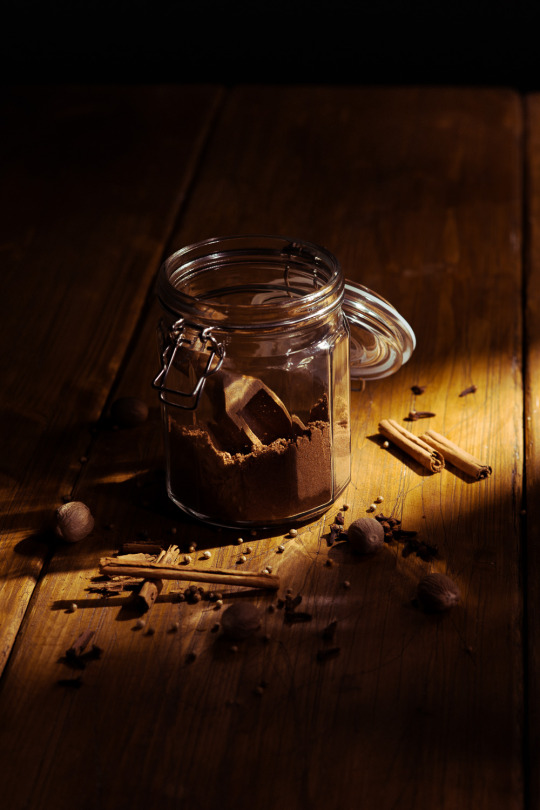
What are your thoughts on expensive photography equipment?
High-end equipment is nice but you can get away with a lot using simple cameras and gear if you know what you're doing. There's a certain beauty in being limited. You learn to overcome challenges and to be resourceful.
Describe your style in 3 words.
Colourful;Balanced;Expressive.
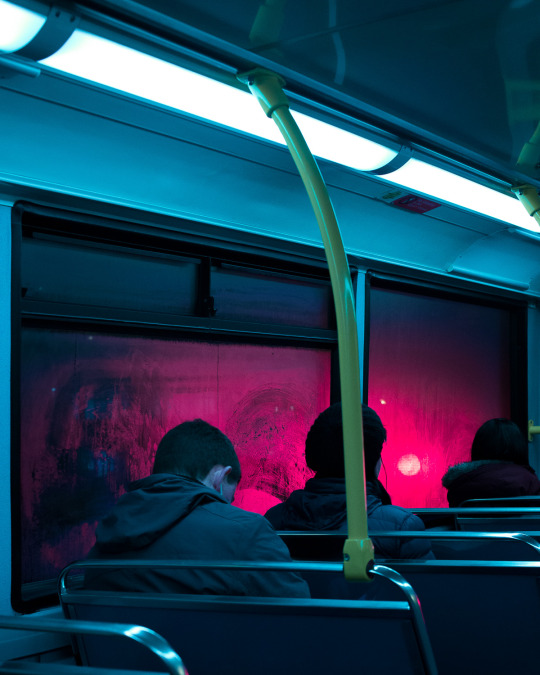
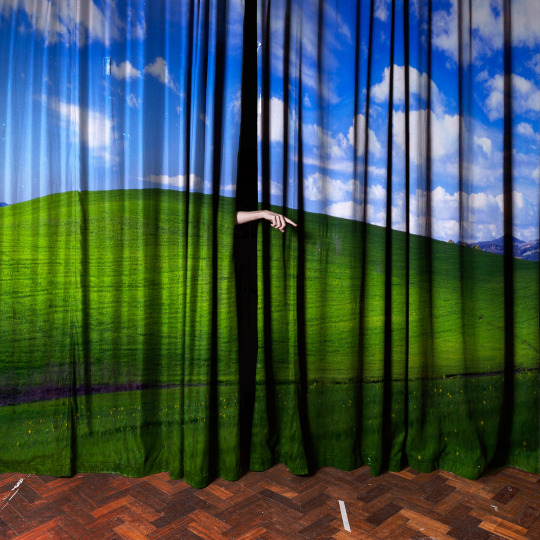
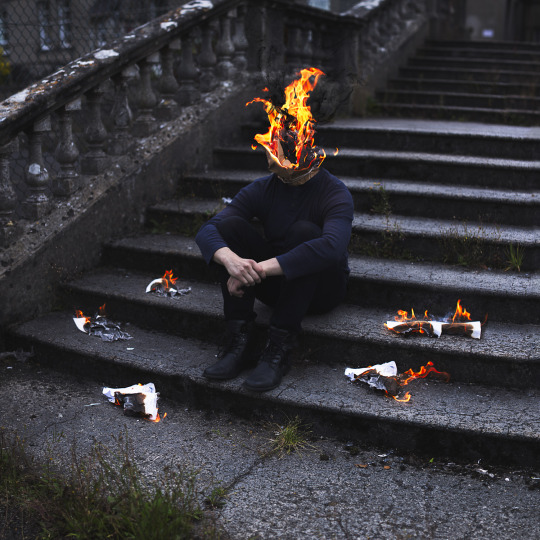
What motivates you?
Good coffee.
Is social media important?
It depends on how you look at it. As a visual creative, I rely heavily on Instagram but I suck at Twitter. It’s very useful because a lot of different types of people use it, and therefore there is potential for a lot of different engagement to come from it as a result. It can open a lot of doors. I think the key thing to focus on is making good material that is interesting to you while staying true to your virtues.
Do you care about following and engagement?
In a way, yes. It can be reassuring to know that people enjoy and value the craft and the material you pour hours of work into, and that it’s being appreciated. I recently started engaging a lot more with my followers and the community at large by responding to posts and stories of complete strangers and enjoying the visual medium together, which I find very interesting. I think it’s about finding a balance between that side of it as well as being able to disconnect from it and enjoy the alone time.
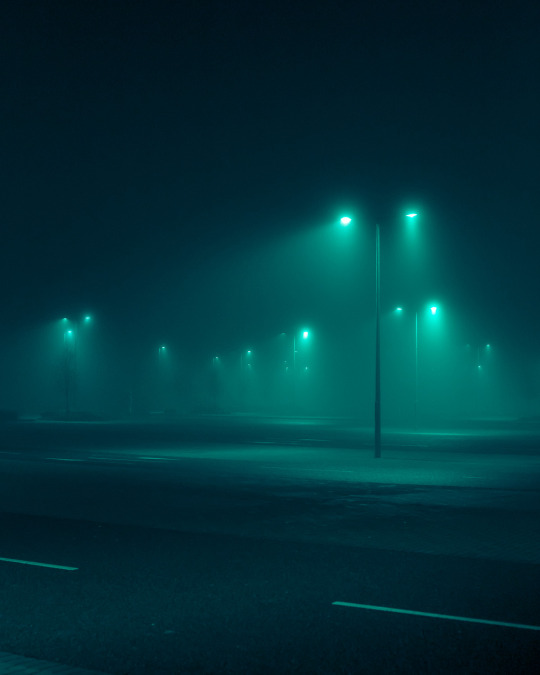
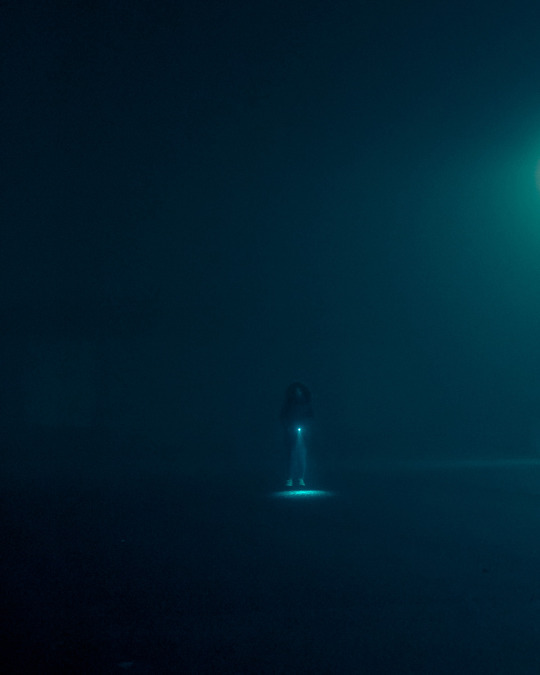
Plans?
Learn, grow, travel, read! There are a few projects that I have lined up for the coming few months, from fine art projects to other work such as the upcoming book. I’m also planning to redesign my personal branding, including my website. That, as well as working on a new short film with my long-time collaborator Kieran Murray.
click here to check out Adrian’s website.
3 notes
·
View notes
Text
Animation is Not Just for Kids
The first essay I ever wrote in college was a “surprising reversal” essay, where we had to take a widespread idea or misconception about something and shed some light on how that idea is actually not true. The topic I chose was how animation is not just for kids-- that adults can like it too. I want to share some of the things I wrote in that essay, but present it in a more informal way. (I got an A on the paper, by the way XD)
[Disclaimer: The only animation I really watch is movies from studios like Pixar, Disney, and sometimes DreamWorks, so those are the main examples I have and what I mainly focus on in this. I’d love to hear thoughts from people who watch animated movies and TV shows from other studios as well!]
-------
Back in the summer of 2018, Pixar released their highly anticipated sequel Incredibles 2. The film was very successful-- it broke box office records and received mostly positive reviews. But controversy soon arose about the language used in the film. One Twitter user addressed the film’s director, Brad Bird, and expressed their displeasure at hearing swearing in a kid’s movie. Bird responded, “With all due respect, it is NOT a ‘kid’s movie.’ It is animated, and rated PG” (@BradBirdA113). This Twitter user’s tweet reflects a common opinion in our culture-- that animation is “kid’s entertainment.”
This sentiment is shared in Hollywood as well. Live action films and shows get more respect, since they are viewed as more “sophisticated” or “mature.” Animated films rarely get a Best Picture nomination, and the Best Animated Picture award has only been around for about 10 years. Directors of animated films have also been quoted as feeling like second-class citizens in Hollywood (Gardetta 272).
As an adult whose favorite films are animated, I have sometimes felt embarrassed when saying what my favorite movie is. But that shouldn’t be the case. In reality, no adult or teenager should feel embarrassed about liking animation, because “the animated cartoon is a perfectly respectable art-form with a considerable tradition behind it and with special advantages for both artist and audience” (Sisk 243). While most people assume animated films or television shows are for children, animation is actually a medium that has value for all ages.
First off, it is important to recognize the difference between a medium and a genre, because the confusion between the two is a major contributor to the misconception of animated entertainment. A medium is the method by which art is created (For example: watercolors, acrylic paints, or charcoal and pastels). A genre is the category of composition within that medium (think landscape, still life, or abstract). Many confuse animation with being a genre when it is actually a MEDIUM of story-telling. There are many genres within the medium of animation such as action, comedy, drama, and so on. Animation is NOT a genre itself. To view animation simply as a genre for kids would trivialize them. Animation is a beautiful art-form. It is extremely flexible, and there are many stories that are just better told through animation than live action (I’m looking at you, live action Disney remakes).
There are many examples of animation that isn’t intended for children at all, or made specifically with adults in mind. I’m going to be honest with you, I don’t know much about these movies/TV shows, but I promise you if you look up “adult animation” you will find them. These shows are labeled this way because they often have strong language, violence, or sexual content. This is why you can’t just throw all animation into a pile and slap a “kid’s media” label on it. There’s definitely animation out there you probably don’t want your kids to be seeing!
Then we have those animated movies and shows that actually are intended for all ages-- the children and family movies, if you will. An adult or teenager can also find rich enjoyment in these films since they often explore complex themes, messages, and emotions that perhaps only an older viewer can truly appreciate. Pixar is especially noteworthy for finding ways to hide in plain sight the existential questions and fears adults face in the disguise of an “innocent” family film. Ellen Scott of Queen's College, City University of New York stated,
“…these Pixar features exploit the tendency of the ratings system to judge the ‘adultness’ of a film based on its sex and violence quotient alone. They remind us of something that the rating system apparently doesn’t know: that sexual titillation and violence are not the only wages of adulthood” (161).
There is no shame in being an adult who doesn’t gravitate towards that more “adult” stuff. I’m one of them. I lean towards family animation because I don’t want to see sex, gore, or strong language. But I do enjoy exploring darker themes and the other aspects of adulthood, because sex and violence isn’t all there is to being an adult.
These films explore the other “wages of adulthood” by incorporating themes such as death, feelings of worthlessness, depression, growing up, and letting go. Themes such as these stimulate discussion and engage the minds of adult audiences.
To illustrate, Toy Story 3 contains arguably one of the darkest scenes in American animated film. You know what I’m talking about-- the incinerator scene. The toys struggle to escape, but soon find themselves accepting the hopelessness of their situation. Grasping hands, they exchange terrified looks as they slowly descend to their seemingly inevitable end. That’s dark stuff! Quite shocking to include in what many might call a children’s film. Additionally, the movie contains many sequences addressing the existential theme of obsoleteness, such as when the toys have to deal with the fear of being discarded before Andy leaves for college. To quote Scott again:
“Ostensibly, of course, the scenes are about toys being thrown out. But they raise deeper questions about death and beyond that the end of material existence--void--that are far more complicated than even those raised in most films with adult ratings” (158-159).
Moreover, the movie’s final moments are tinted with melancholy as they compel us to contemplate our own childhoods and how we had to leave them behind. I saw this movie for the first time when I was 10, and that final scene affects me more now than it ever did as a child.
The fact that these films can relate to both children and adults is part of why they are so impressive. Take Finding Nemo for example. While kids might relate to Nemo and his plight of having an overprotective parent and learning to become more independent, adults might relate more to Marlin and his struggles with anxiety and raising a son as a single father.
But Pixar isn’t the only animation studio investigating these deep, and sometimes thoroughly adult, themes. Disney’s Hunchback of Notre Dame, while modified from the original novel to be more suitable for a family audience, still deals with obsession, lust, and genocide. In the DreamWorks film How to Train Your Dragon 2 (spoiler alert), Hiccup’s father is actually killed by a mind-controlled Toothless. There are so many other examples, and ones that are far better than these, I’m sure. These films aren’t just mindless fluff, there are real, difficult concepts in them that make them extremely compelling, accessible, and enjoyable for all ages.
But what about those animated films that are truly intended specifically for children? What about animated media that maybe isn’t so deep or philosophical? You know what-- YOU CAN ENJOY THOSE AS AN ADULT TOO. Sometimes we don’t want to contemplate our existence or the meaning of the universe while consuming media. Sometimes we just want to have fun with our comfort TV show or movie.
Basically what I’m trying to say is, who cares what the intended audience is supposed to be. Watch what ever makes you happy! Just don’t disregard animation because of its reputation of being childish, because that is far from the truth. It’s a fantastic medium with fun to be had for every age.
To finish, I’ll share this quote from Daniel J. Moloney, a dean at a university in Pennsylvania (in context, he’s talking about the Disney renaissance movies, but I think it applies to most animated family movies/shows. My main point in this essay to point out that children and family movies are just as valuable for adults, and I think this quote drives that point home):
“So just what is the appeal of animated films for so many adults? On a purely objective level, the films are works of technical and artistic genius. They present excellent music and lyrics and incorporate elements of comedy, drama, and suspense. They sport good scripts and field fine voices. Their visual and auditory presentation is so powerful it can bring an audience to the point of awe.
But it is not only their objective qualities that make these films so wildly successful. I believe the most compelling element of these animated films is that they tap into the heart of the human struggle: our day-to-day relationships with one another and our tattered but unshakable belief in goodness. In these films there is little gratuitous violence, no foul language, no discomforting sex, no overt politics, and no religious controversy— staples of our daily life and most of our cinematic entertainment.
Even more important, the viewer of these films can be fairly confident that good will prevail, that by the time the final credits roll, the transformative power of love will have been affirmed. In a word, these films give us hope.”
What do you think? Do you agree or disagree? I’d love to hear your thoughts on this subject! Also, let me know what your favorite animated movies and TV shows are!
-------
Works Cited
@BradBirdA113. “With all due respect, it is NOT a “kids movie”. It is animated, and rated PG.” Twitter, 2 July 2018, 3:10 p.m., https://twitter.com/BradBirdA113/status/1013907729461727232
Gardetta, Dave. “Mr. Indelible: Brad Bird’s The Incredibles May Have Left a Permanent Mark on Filmmaking, but Animation Directors Still Can’t Get No Respect in Hollywood.” Los Angeles Magazine, no. 2, 2005, p.78. EBSCOhost.
Maloney, Daniel J. “No Admittance without Children.” Commonweal, no. 13, 14 July 1995, p. 30. EBSCOhost.
Scott, Ellen. “Agony and Avoidance: Pixar, Deniability, and the Adult Spectator.” Journal of Popular Film and Television, vol. 42, no. 3, 2014, pp. 150-162. EBSCOhost, doi:10.1080/01956051.2014.881773.
Sisk, John P. “The Animated Cartoon.” Prairie Schooner, vol. 27, no. 3, 1953, pp. 243–247. JSTOR, www.jstor.org/stable/40624571.
#animation#pixar#disney#dreamworks#animated movies#animation is not just for kids#cw sex mention#essay#jc speaks
7 notes
·
View notes
Photo

Why Should You Go For Premium WordPress Themes By VWThemes
The internet is flooded with websites out of which more than 38% are WordPress based and this is because of the free availability and immense ease of use that WordPress as a CMS provides. Ever since the evolution of WordPress themes, web designing has undergone a revolution. The conventional web designing process that included writing cumbersome and complicated codes for every single content element you wish to include in your website is replaced by a readymade skin and inbuilt customization options. Since then, not even novices but also professional web developers go for WordPress themes for any of their website projects.
With the increasing competition among businesses in the race for their survival, building unique websites becomes more important as a mere online presence will not serve the purpose. For this, developers opt for premium WordPress themes. Though free WP themes can get you a comprehensive presence, they do not guarantee distinctiveness. But for establishing your brand identity and making it get noticed among the crowd, it is important to look out of the box. Premium WP themes can easily help you achieve this.
Where To Buy Premium WordPress Themes? There are many premium theme providers that sell the themes. However, you need to go for themes only from reliable and trusted providers. You might fancy the attractive prices and discounts offered on different websites while you go searching for good themes but keep in mind that not all themes are created equal. So always trust the trusted one. VWThemes is one such marketplace where you will find the top premium quality themes. Our themes are built considering the latest market trends and requirements of respective businesses. The default layouts of the themes are well-tuned to match the type of business and profession they are designed for. Our developers have done all the hard work to make sure that they deliver only the best theme by using cutting-edge technology.
The Perks Of Our Premium WordPress Themes 1. Loads of Features The major attraction of our premium themes is their abundance of features. They are accompanied by an inbuilt admin-panel where everything can be easily controlled in the front-end. The customizable content sliders look great. The social media icons integrated into the theme works magnificently in promoting your services on social media platforms. As the SEO of your website plays a major role in making your website noticed, our developers have provided SEO optimized codes in the core. All our premium themes are designed up to the mark and play a significant role in making your website SEO friendly so that you are able to get more organic traffic.
2. Responsive Responsive web design is very crucial for your website’s success. With a responsive theme, your website gets the ability to give an optimal viewing and interactive experience to the viewers who are accessing your website through a variety of devices and platforms. All the themes available at VWThemes are made responsive. This means the websites that you design using these themes will not only look good on desktops but also function properly and look fab when any of the viewers try to view your site on the mobile phone. As we have already done the hard work for you, just don’t worry about the responsive part.
3. Unencrypted Footer The major concern and a big cause of worry for those who are looking to use free themes is the encrypted footer. This is really important and worth considering before using any free theme as the encrypted footer may have a lot of good as well as bad links associated. Encrypted footer mostly contains the paid links which can have a negative impact on your website’s SEO. However, with our premium WordPress themes, the scenario is completely different. The codes are cleaner, thoroughly tested, and there is nothing hidden in them. You can put your trust in our themes and you will never be disappointed.
4. Secure and Timely Updated When you purchase premium WordPress themes from a reputable resource, you don’t get malicious codes with the themes. On the other hand, for those who are tempted by the word ‘free’, you all need to know that not everything you get free is good. The themes you get for free are often packed with poor quality codes. VWThemes has been there for a long while and has carved its niche in the WP themes market. All this was possible because of the quality of themes that are developed here. All themes are packed with well-written and secure codes that make it tough for hackers to penetrate into your website. Apart from this, we keep on releasing the updated versions of our themes to ensure the smooth and secure functioning of your site.
5. Guaranteed Uniqueness If a free theme looks good to you, there is a possibility that many others might have found it good, and that particular theme might already have millions of active downloads. As an outcome of this, there might be many similar-looking websites on the internet.
For ensuring that you get a unique look for your website, a premium WP theme is always the best option. Premium themes come with premium WordPress templates and offer a larger variety when it comes to design elements along with customization options. This makes a huge difference while creating a distinct and unique website.
6. Continued Support Choosing paid WordPress themes always benefits you as your one-time investment can leave you assured for years to come. As a part of premium WP themes, dedicated support is also provided by the developers. At VWThemes, we believe in complete customer satisfaction and are always ready to give all the possible help to them day in and day out.
Have a glance at some of our most loved themes and be assured of the top-notch work we do.
VW Ecommerce Shop
With this Ecommerce WordPress Theme, setting up a website is no more a tricky task. You won’t face any difficulty in using it for your eCommerce web project as this theme has a user-friendly theme options panel. It facilitates users with a lot of options for easy and smooth customization. This theme has been churned to perfection so that you can get the best possible website to make your eCommerce business a successful one. The SEO optimized codes, translation ready design, and a long list of features along with the top-notch technology used by the developers together make a great combination for getting amazing eCommerce business websites.
VW Gardening Landscaping
Get a professionally crafted website for your gardening and landscaping business with this Landscaping WP theme. With its visually appealing design that seems perfect for your gardening business website, you can achieve outstanding results for your business. Apart from visual aesthetics, its amazing features empower you to take your website to the next level. It contains SEO friendly codes, has WPML compatibility, and supports plugins. You do get an additional advantage of timely updates and 24/7 support.
VW Minimalist Pro
Minimalism is the new normal that has set a trend when it comes to WP websites and this Minimalist WordPress Theme is a perfect example of how effective and classy your business website can look using a minimalist design. It is a multifunctional theme with its use extending to several business domains. With just the right elements included, it keeps the interest of your visitors intact and highlights all your important content. With its different sections, showing your quality work and info is possible which also makes your website look uncluttered and sorted. It is responsive, shows compatibility with all the popular web browsers, and has all features and functionalities to build a perfect website.
#premium WordPress themes#premium WordPress templates#premium wp theme#WordPress premium templates#WordPress Themes
0 notes